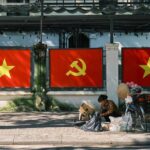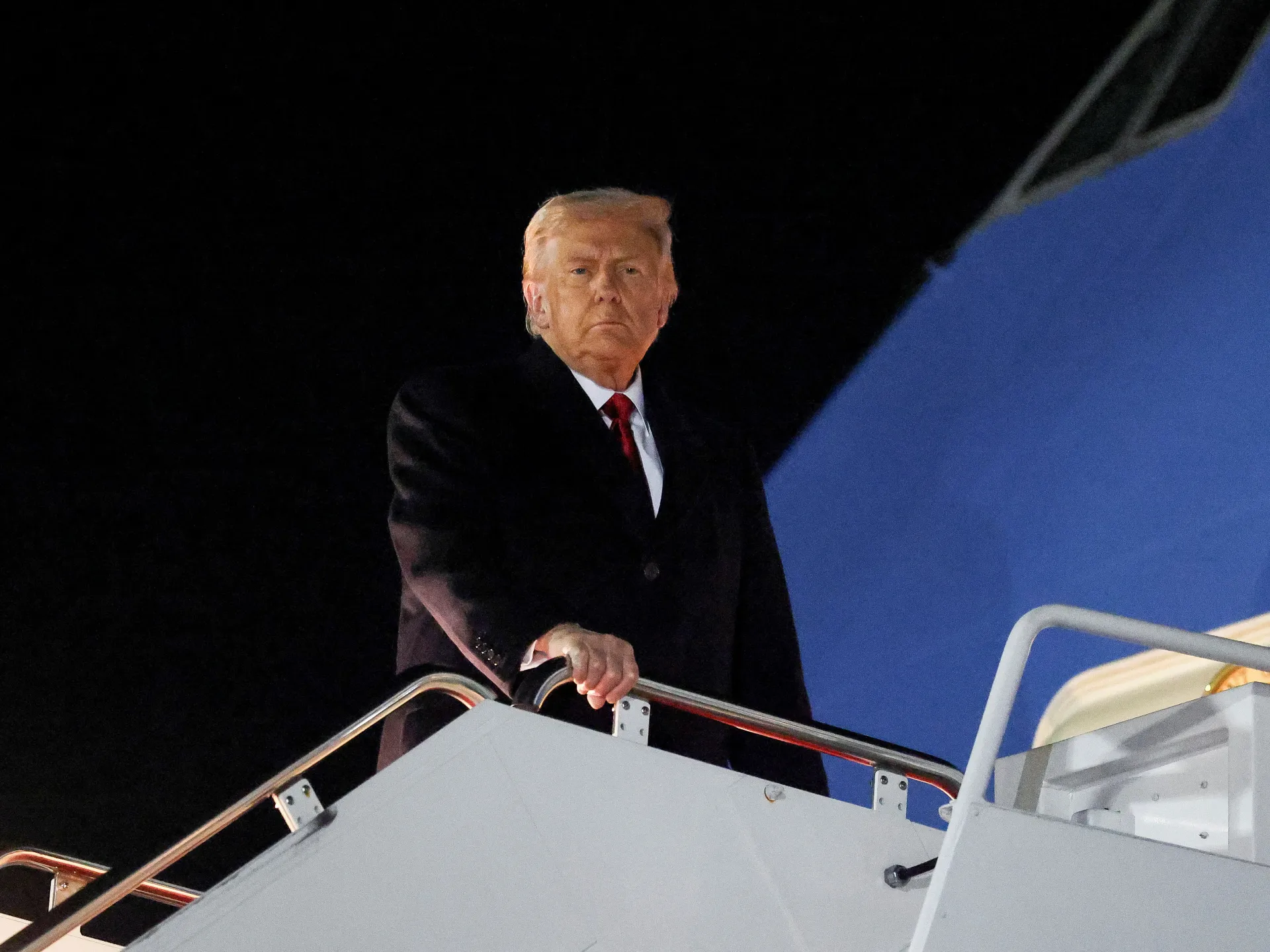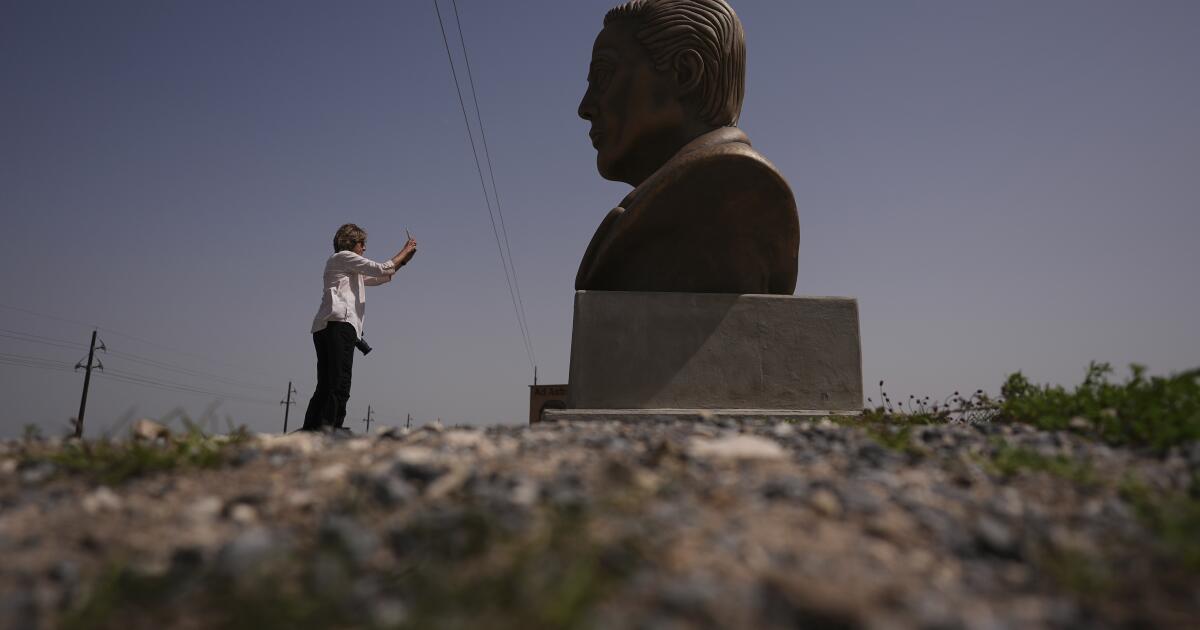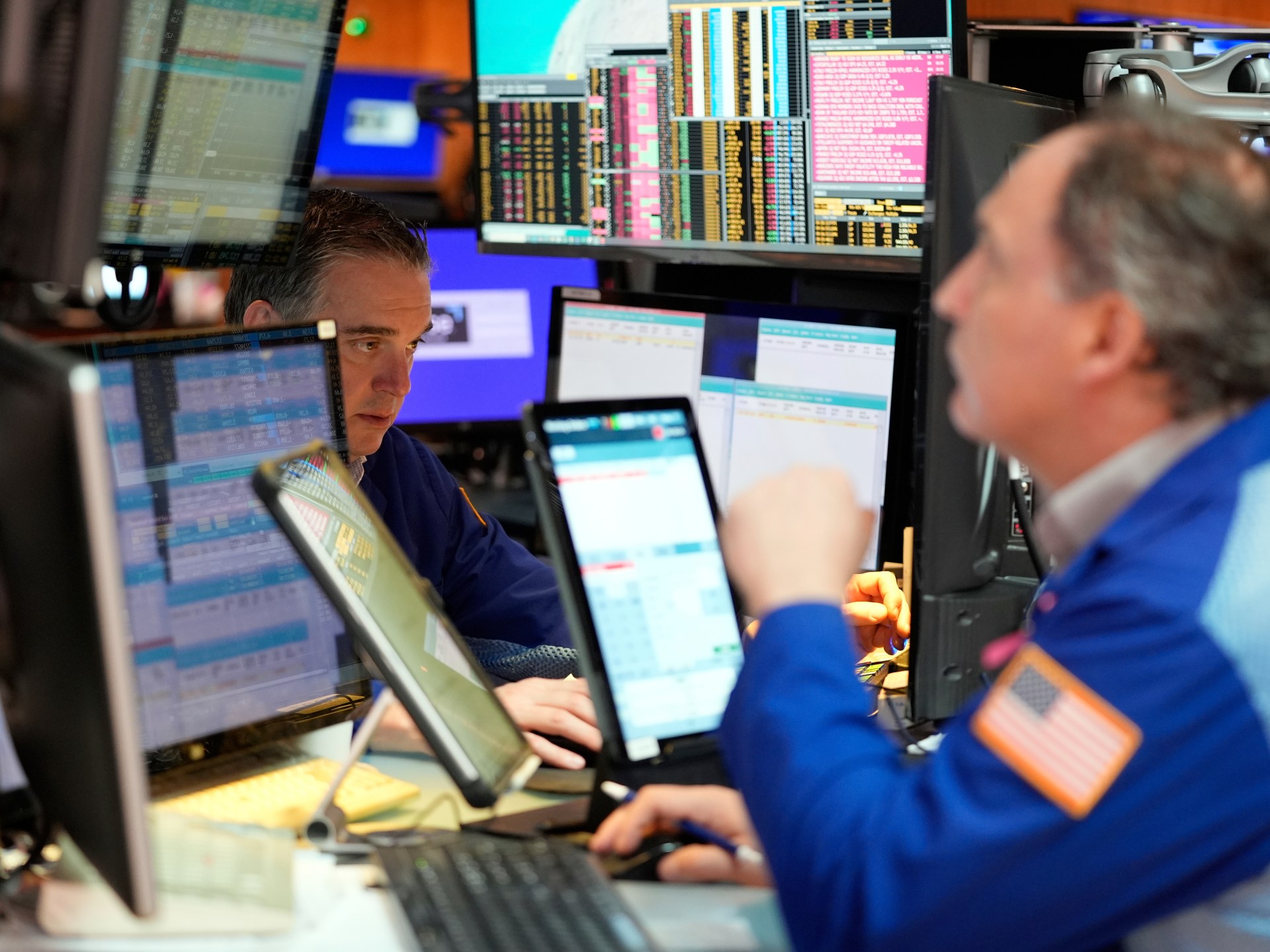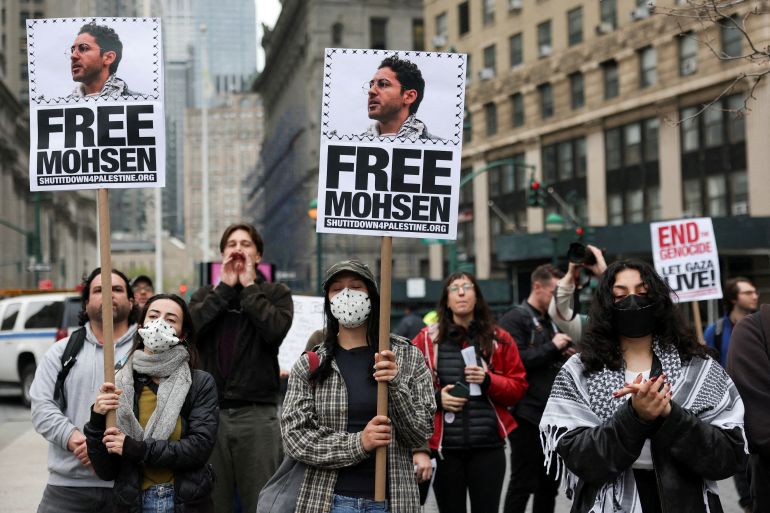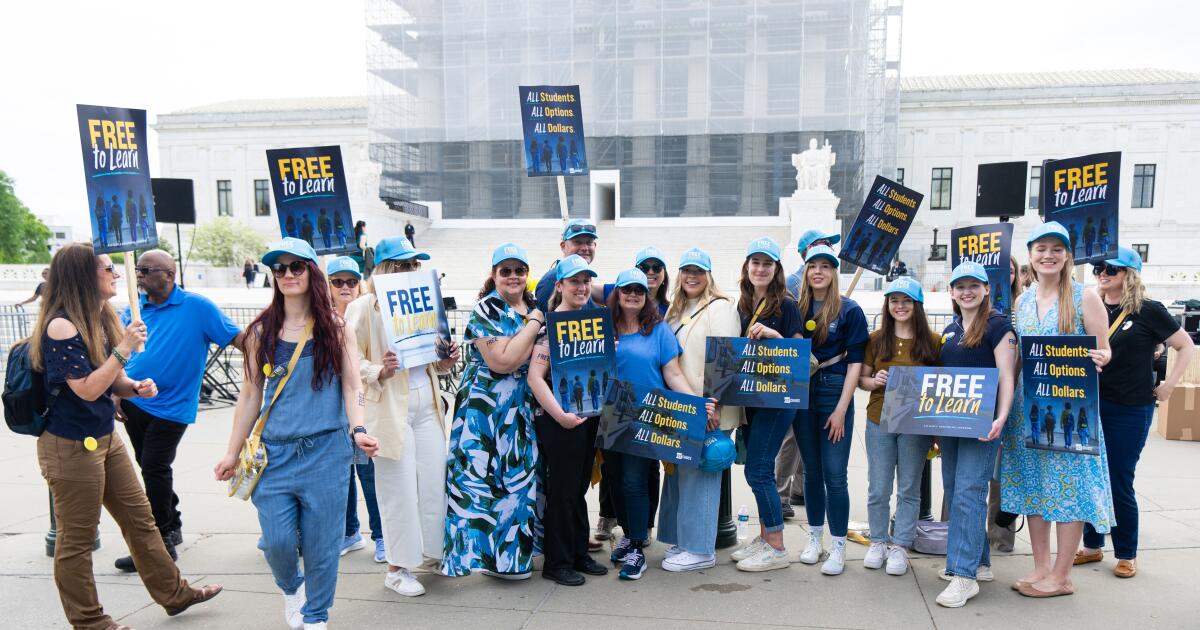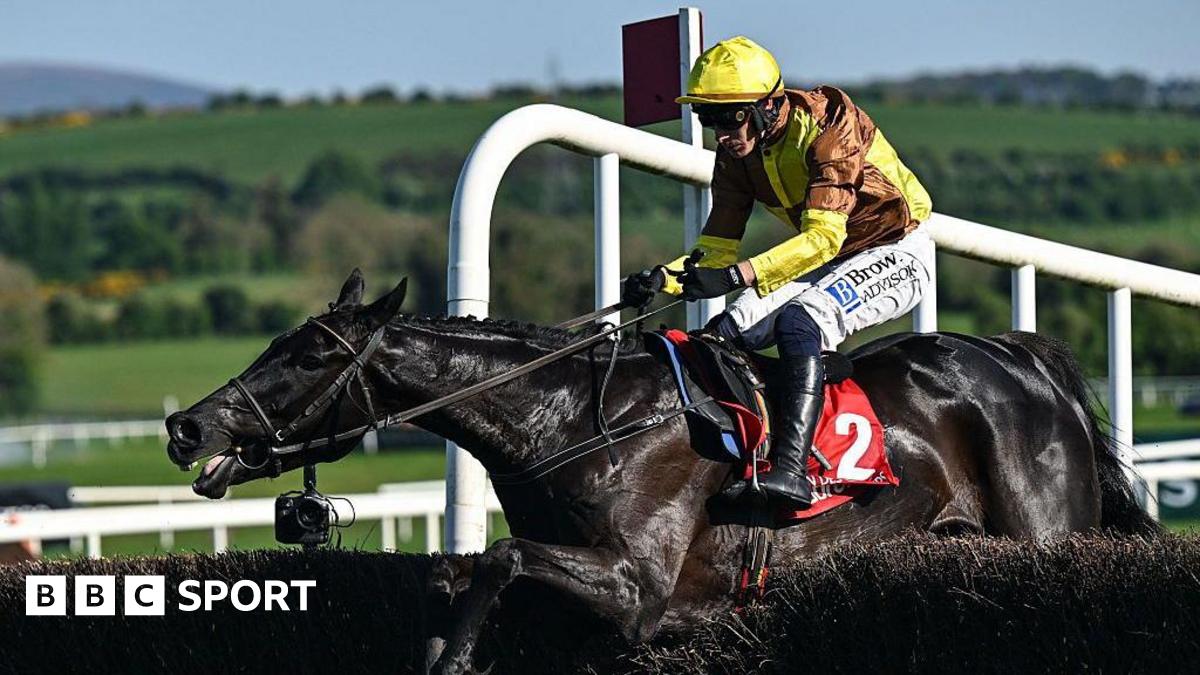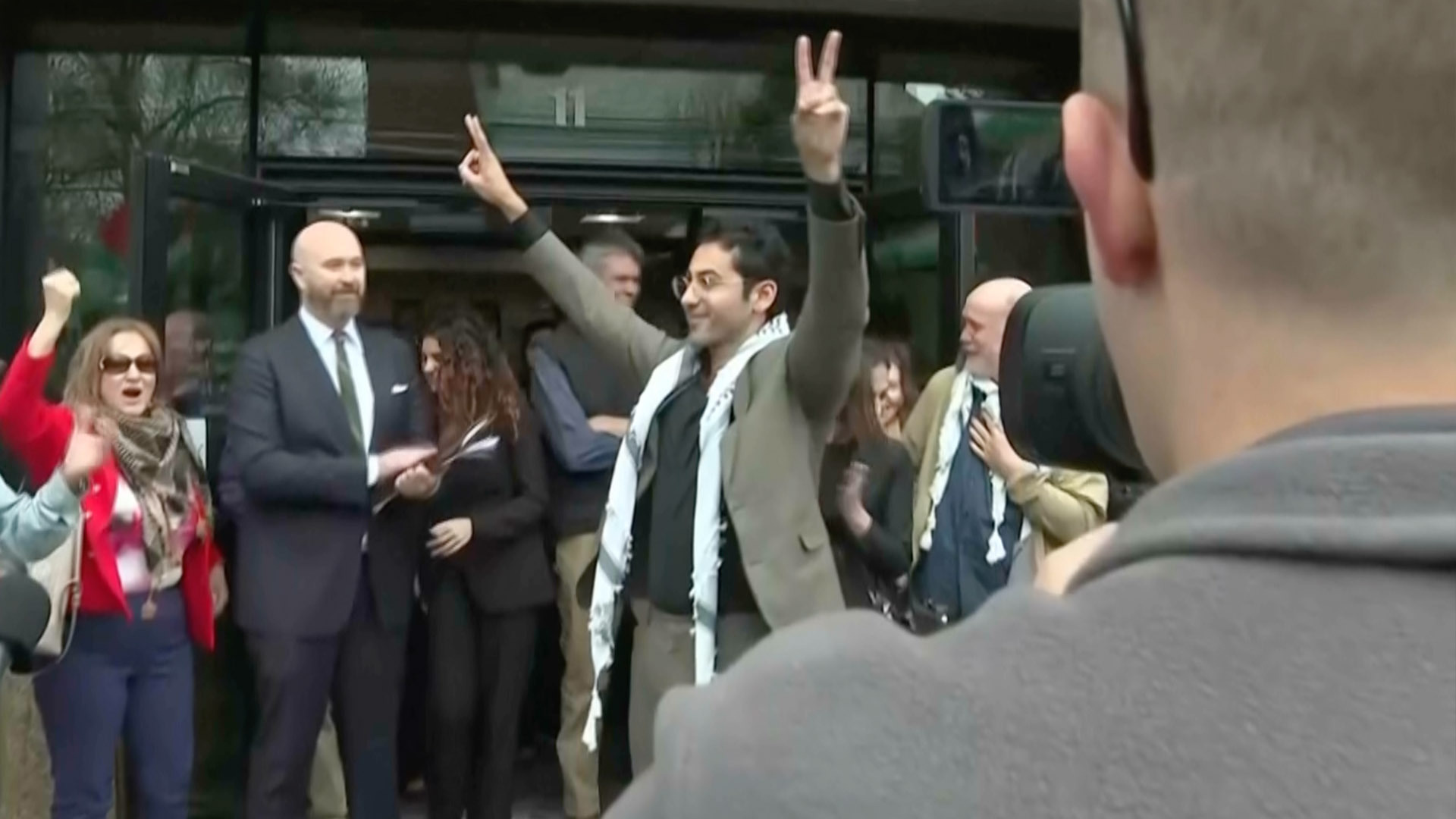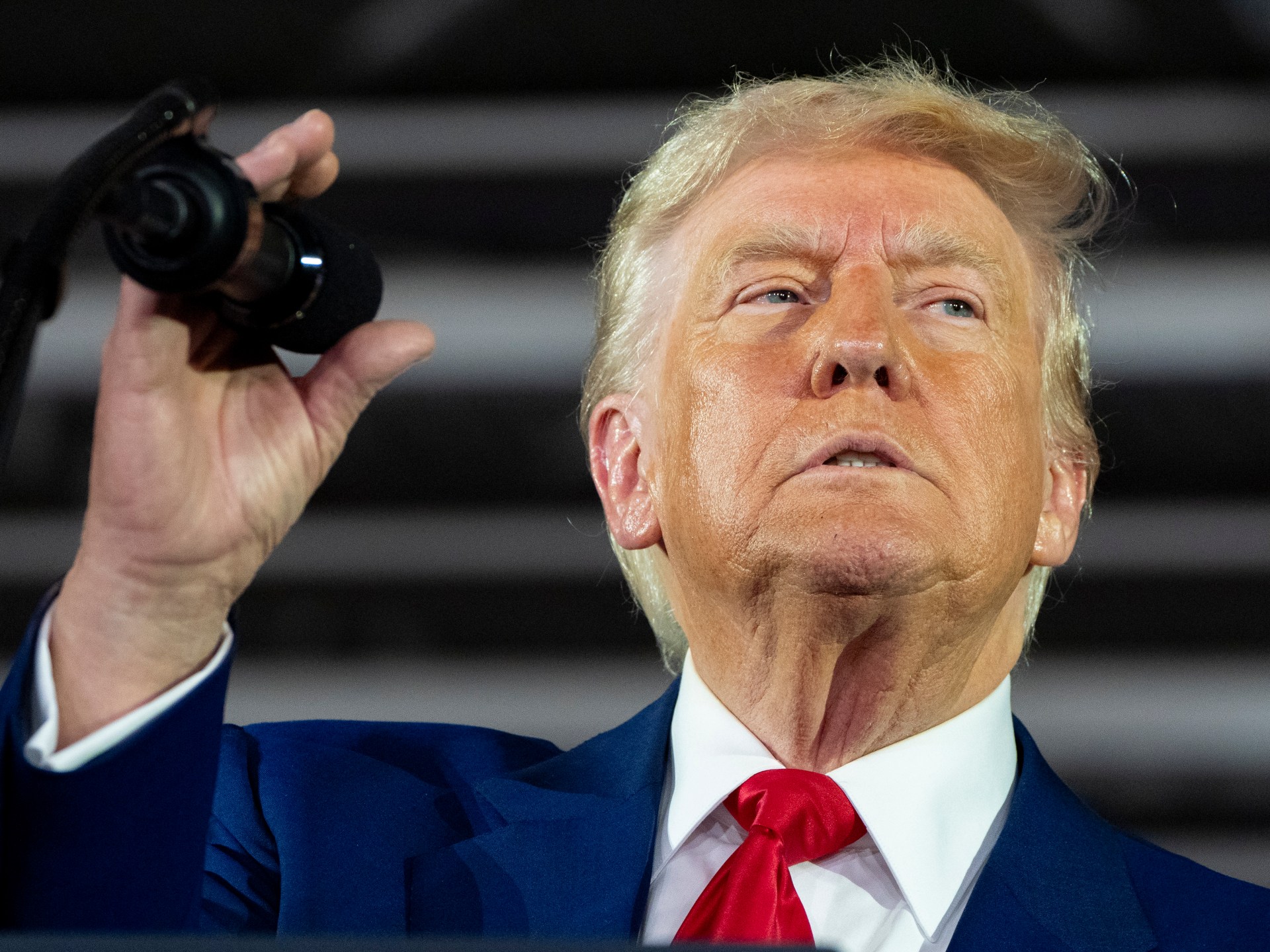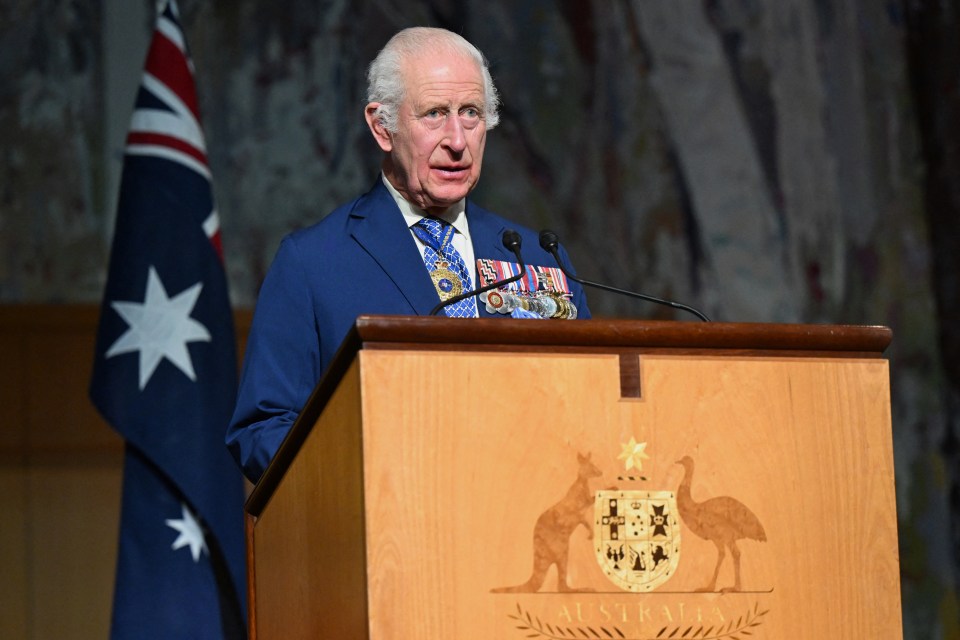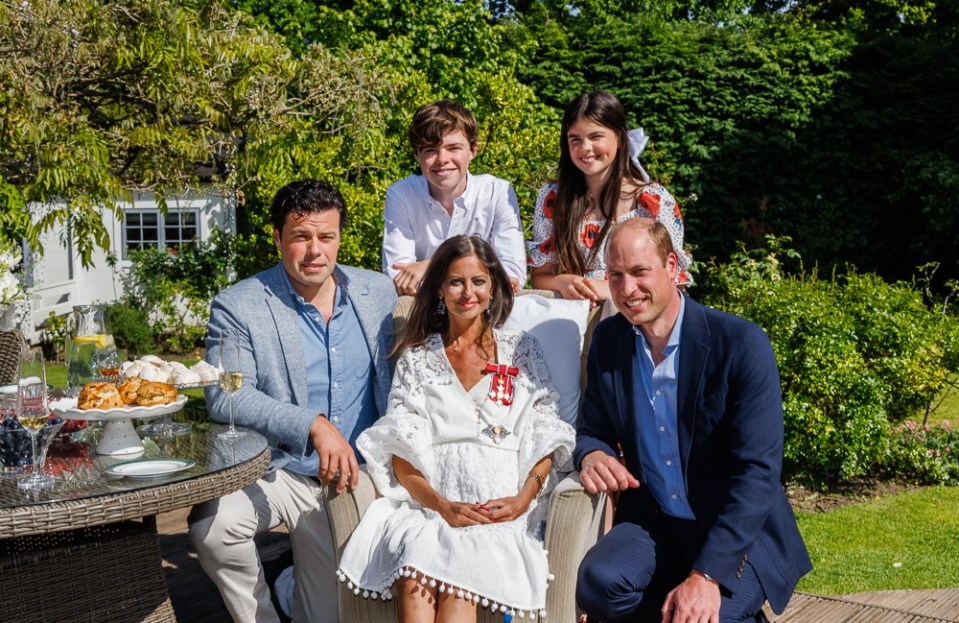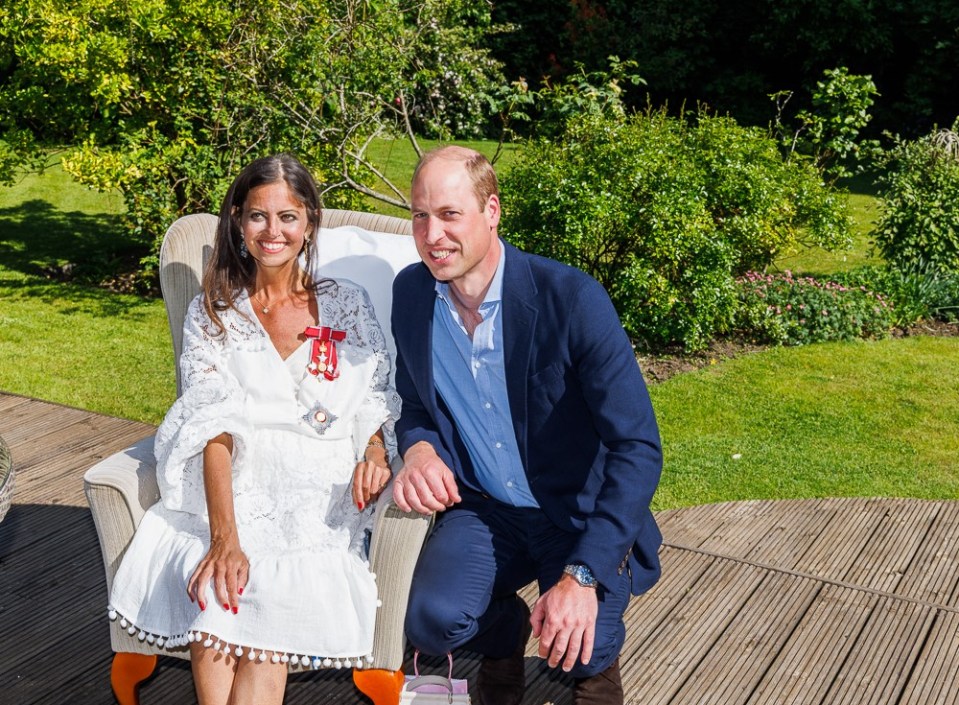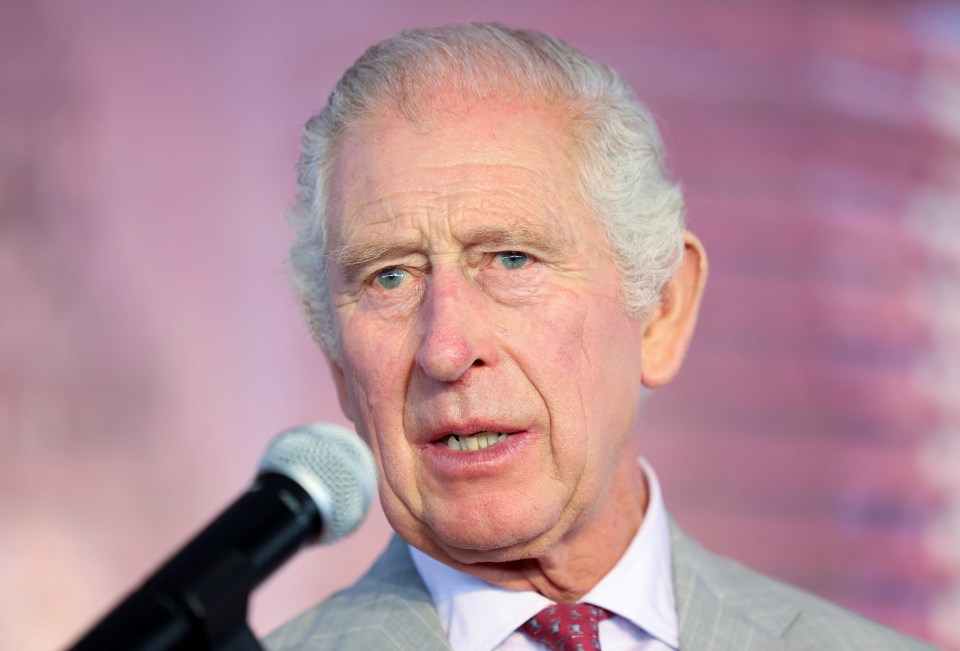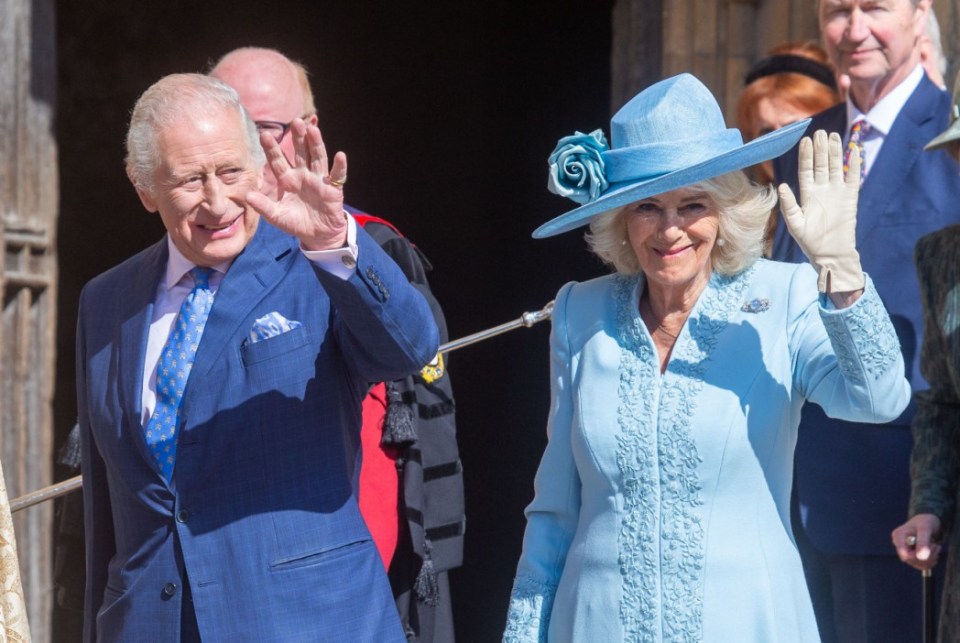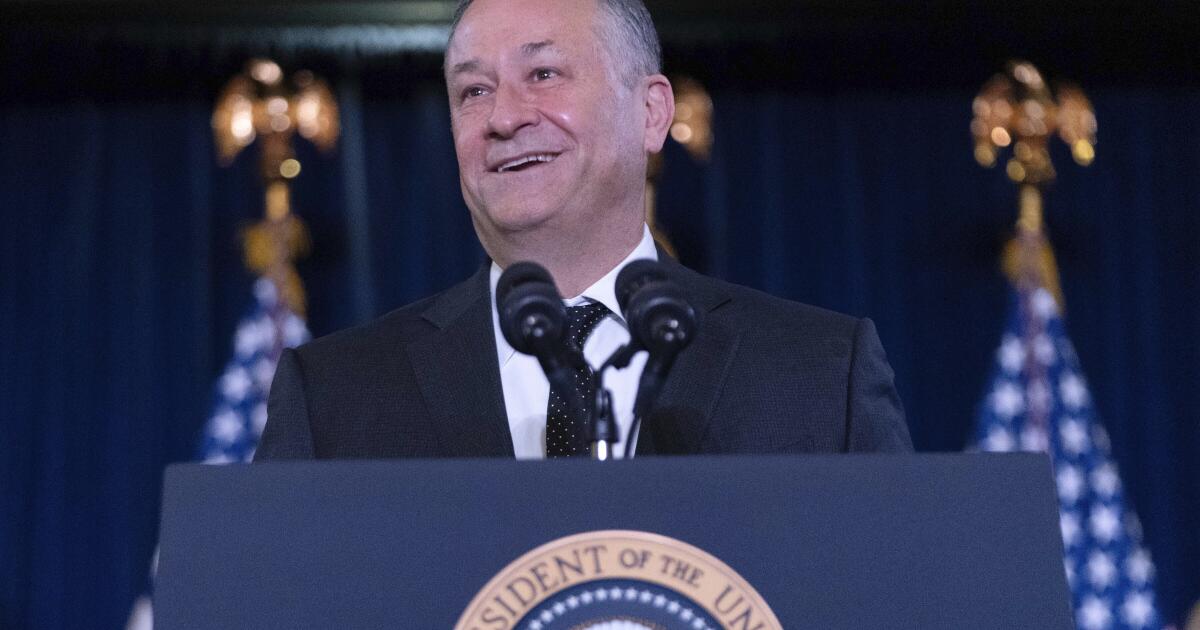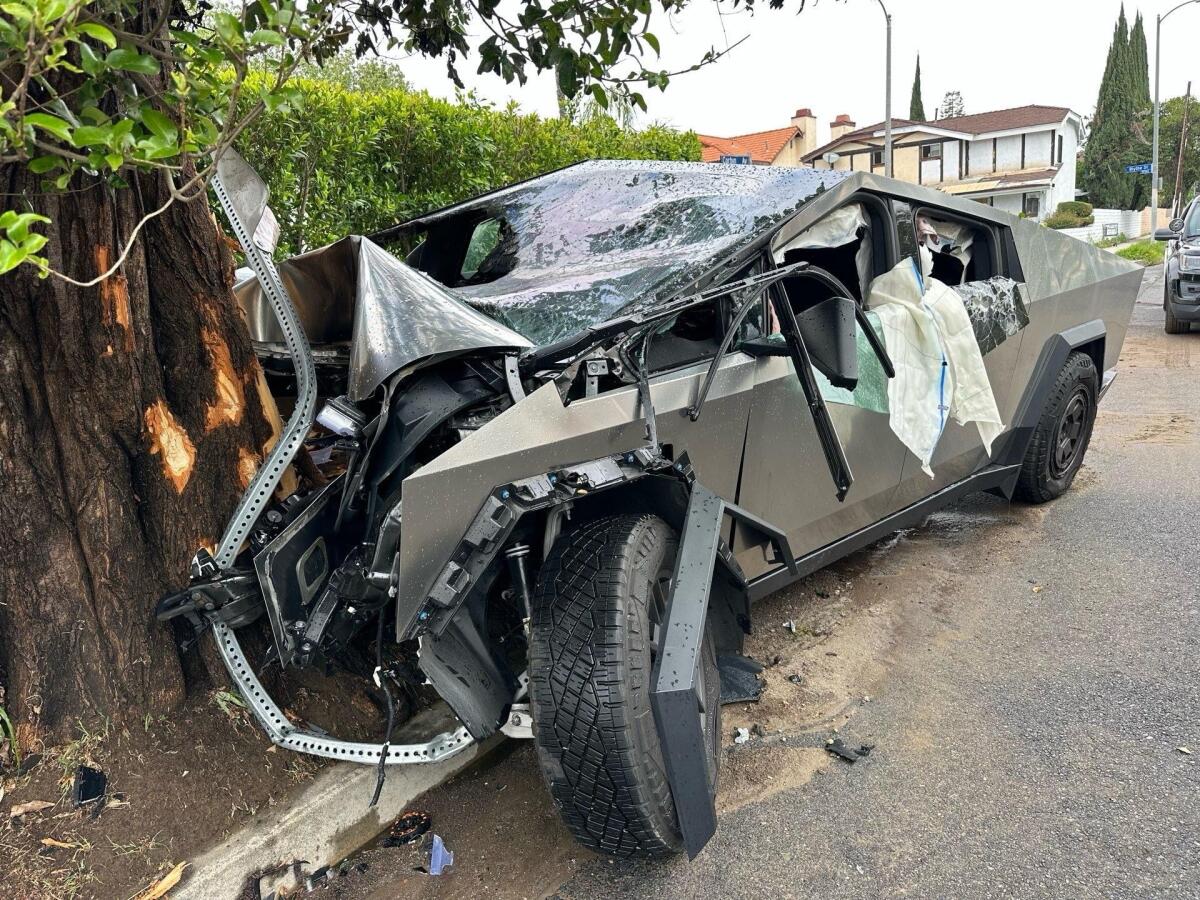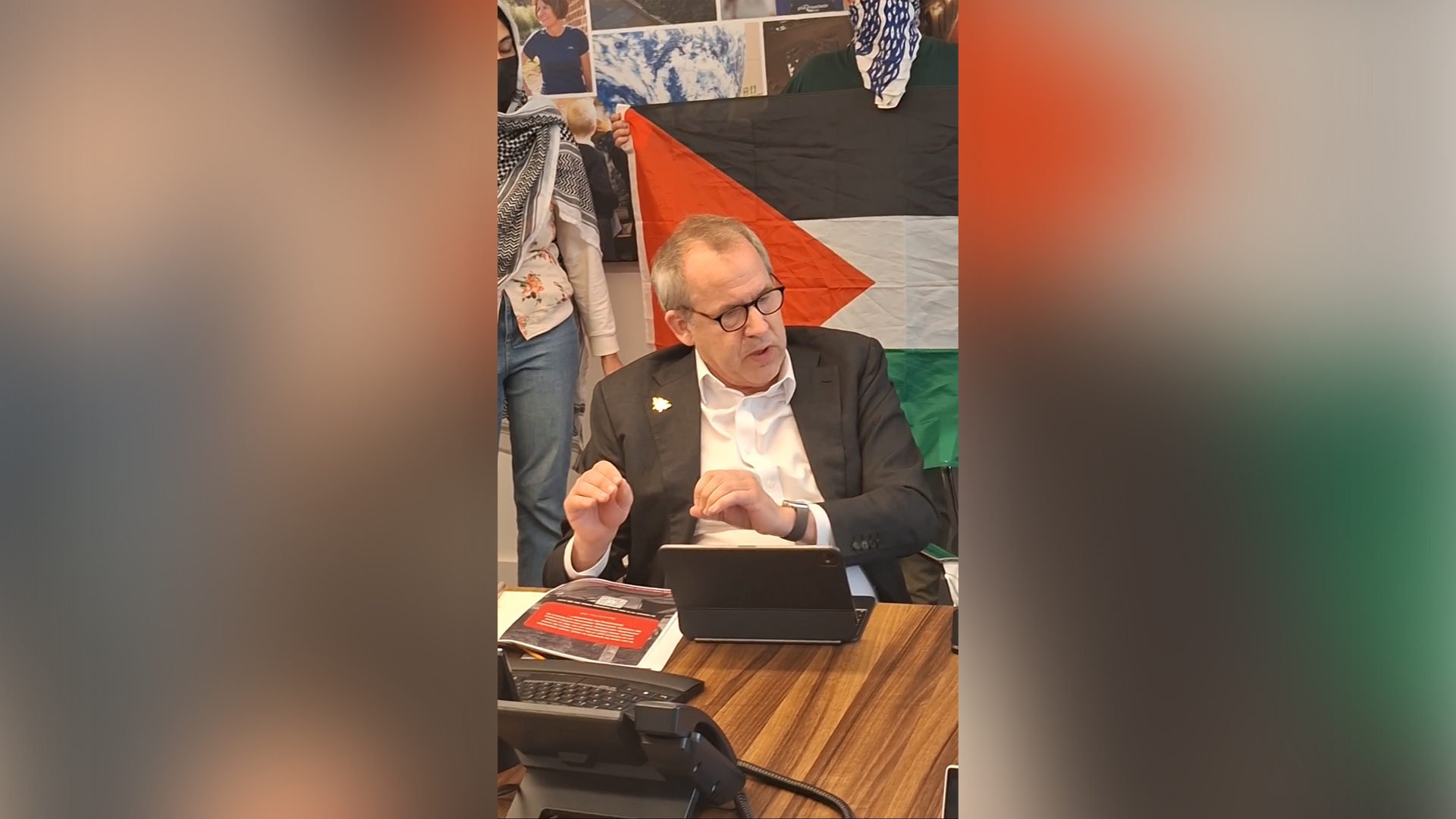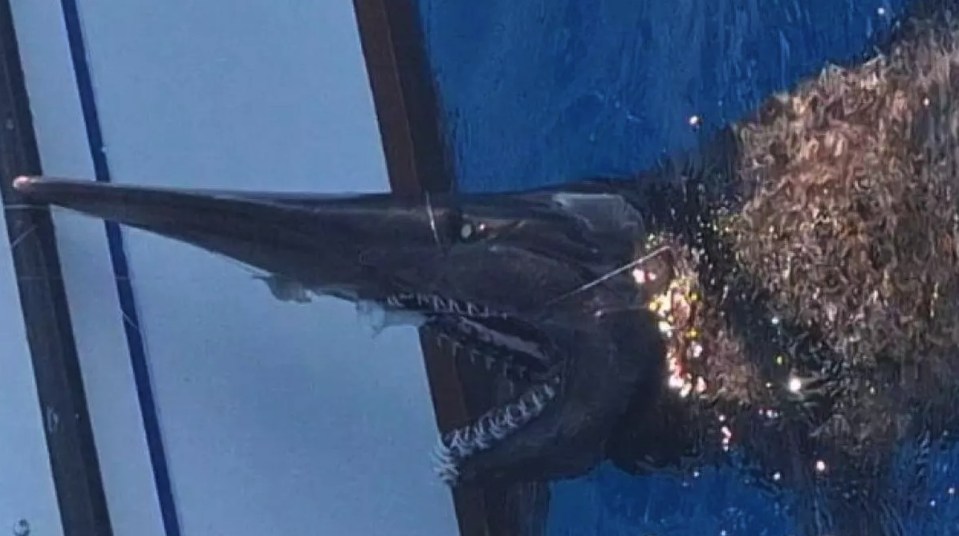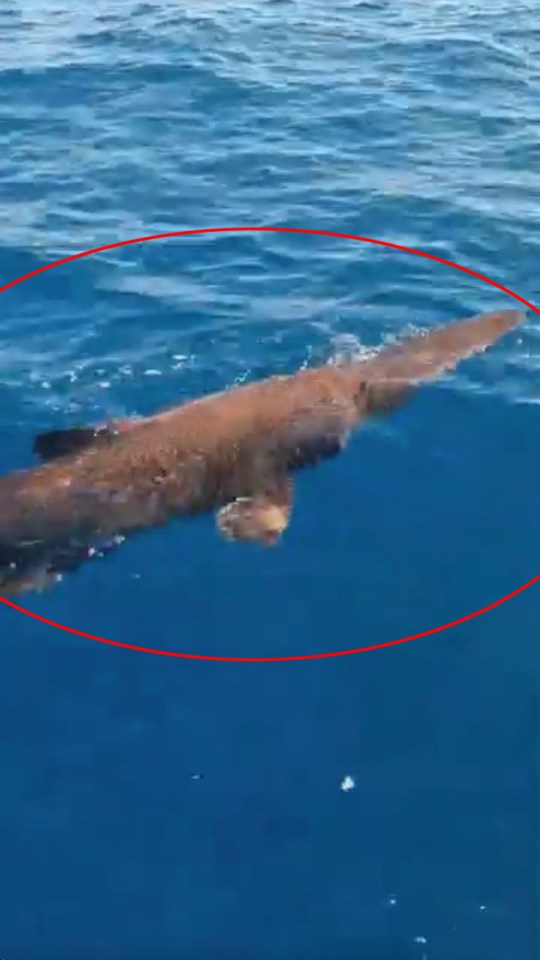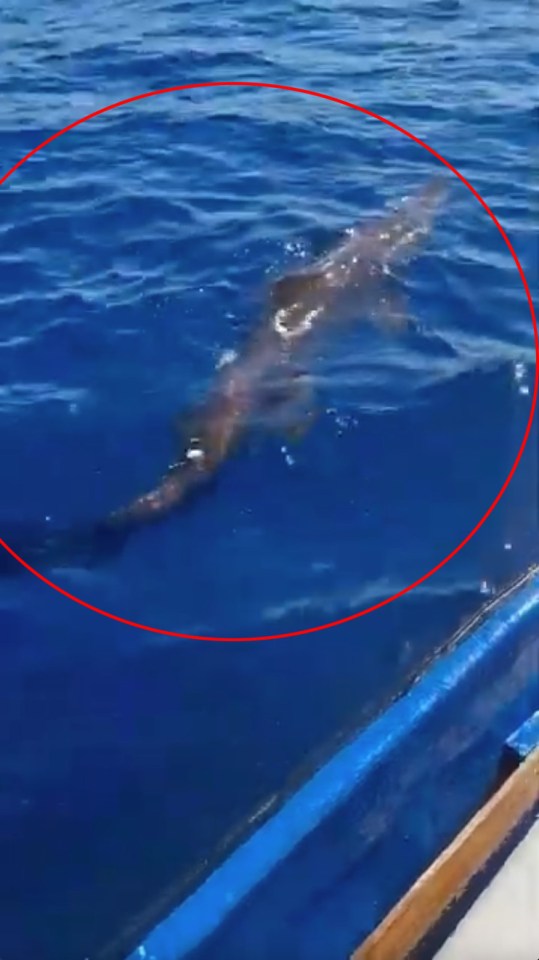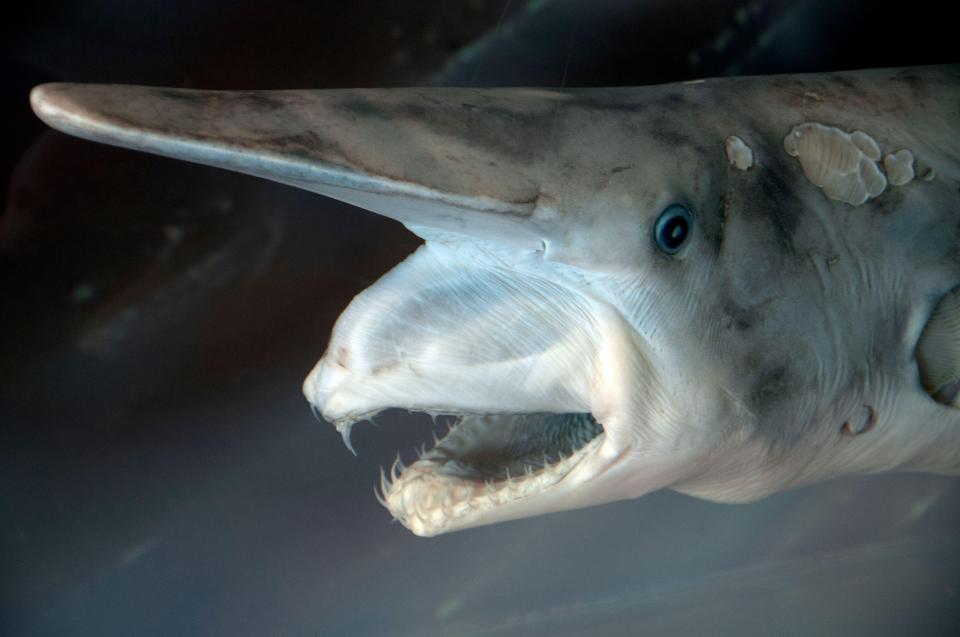The home of Elon Musk’s SpaceX could become an official Texas city called Starbase
AUSTIN, Texas — Elon Musk has for years made Texas a business home and playground, launching rockets, building cars, and dreaming about creating a utopian enclave for his workers on the rural outskirts of the state capital.
Now, a new Musk project is on the brink of victory: an election Saturday to officially turn a small patch of coastal South Texas — home to his rocket company SpaceX — into a city known as Starbase.
If Musk prevails — which appears likely, since the small number of residents eligible to vote include his employees — it will be a victory for the mega-billionaire whose popularity has waned since he became the chain-saw-wielding public face of President Trump’s federal job and spending cuts, and sunk more than $20 million into a failed effort to tip Wisconsin Supreme Court elections. Profits at his Tesla car company have plummeted.
As of Tuesday, nearly 200 of 283 eligible voters had already cast an early ballot, according to county election records. The list of names so far does not include Musk, who voted in the county in the November elections.
The cosmic dateline sounds like a billionaire’s vanity project in an area where the man and his galactic dreams already enjoy broad support from residents and state and local officials. But there are creeping concerns that the city vote and companion efforts at the state Legislature will give Musk and his company town too much control over access to a popular swimming and camping area known for generations as the “poor people’s beach.”
Setting up a company town
Saturday’s vote to establish Starbase is seen as a done deal.
The proposed city at the southern tip of Texas near the Mexico border is only about 1.5 square miles, crisscrossed by a few roads and dappled with airstream trailers and modest mid-century homes. The polling site is in a building on Memes Street, a cheeky nod to Musk’s social media company X.
Musk first floated the idea of a Starbase city in 2021. SpaceX officials have said little about exactly why they want a company town, and did not respond to messages seeking comment this week. But a fight over beach access highlights at least part of what could be at stake.
SpaceX rocket launches and engine tests, and even just moving certain equipment around the launch base, require closing a local highway and access to Boca Chica State Park and Boca Chica Beach.
Closure currently requires collaboration with surrounding Cameron County. Two bills being considered by state lawmakers would move most of that responsibility to the the new city, just as the company seeks permission from the Federal Aviation Administration to increase the number of launches from five to 25 a year.
SpaceX officials say the bills would streamline beach closures and operations at a company that has contracts with the Department of Defense and NASA for use of its heavy rocket Starship, including a goal to send astronauts back to the moon and eventually Mars.
“This fully reusable rocket system keeps the U.S. ahead of global competitors like China, and it’s being developed right here in South Texas,” Sheila McCorkle, SpaceX vice president of Starship legal and regulatory, wrote to state lawmakers. She noted the company’s $4-billion investments and thousands of jobs in Texas.
“We need to carry on our mission of turning South Texas into the Gateway to Mars and making humankind multiplanetary,” McCorkle wrote.
Public pushback
A legislative hearing this month on the beach access bills drew just a handful of company executives and environmental activists but generated hundreds of comments from supporters and opponents.
Dozens of people who identified themselves as SpaceX workers, scientists and engineers living in the area submitted identical statements: “It improves coordination around beach access during spaceflight activities without increasing closures. This is key to public safety and continued growth of the space industry in Texas.”
Others praised SpaceX’s mission, jobs and investments in the area.
Opponents countered that the state would be giving Musk and his company too much control over a beach that draws tens of thousands of visitors every year.
Cameron County Judge Eddie Trevino Jr. said the county has been a good steward for beach closures and that there is no need to move the authority to the new city.
“SpaceX is a strong economic driver in our region, one of which we are extremely proud,” Trevino said in a letter to state lawmakers. “However, we believe that this bill does not serve the public interest and has received an overwhelmingly negative response from our local community,”
Another proposed bill would make it a Class B misdemeanor with up to 180 days in jail if someone doesn’t comply with an order to evacuate the beach. But that measure would only take effect if beach closure authority is shifted to the new city.
In a temporary setback for Musk and SpaceX, a state House panel this week rejected a bill that would shift control of closing beaches for rocket launches from the local county government to the new city.
Bekah Hinojosa, co-founder of the South Texas Environmental Justice Network, has organized protests against the city vote and the beach access issue. The group will hold another protest on Saturday, even though the city will likely be easily approved.
Hinojosa said her organization tried to organize a block walk around SpaceX to encourage voters to reject the city vote. The company’s private security escorted them away, she said.
“We’ve been sounding the alarm about Musk and SpaceX for many years,” Hinojosa said. “Now that the rest of the country is starting to listen, it feels like we’re finally being heard.”
Vertuno writes for the Associated Press.
High school beach volleyball: Southern Section girls’ playoff results and updated pairings
SOUTHERN SECTION GIRLS BEACH VOLLEYBALL PLAYOFFS
TUESDAY’S RESULTS
QUARTERFINALS
DIVISION 1
Mira Costa 4, Edison 1
Los Alamitos 4, Santa Margarita 1
Redondo Union 4, San Marcos 1
JSerra 5, San Juan Hills 0
DIVISION 2
South Torrance 3, Crean Lutheran 2
Millikan 3, San Clemente 2
Capistrano Valley Christian 3, El Segundo 2
Santa Barbara vs. Long Beach Wilson, today at 3 p.m. at Santa Barbara East Beach
DIVISION 3
Campbell Hall 3, Warren 2
Anaheim Canyon 4, Capistrano Valley 1
Long Beach Poly 3, Laguna Blanca 2
Linfield Christian 4, Laguna Hills 1
THURSDAY’S SCHEDULE
(All matches at 2 p.m. unless noted)
SEMIFINALS
DIVISION 1
Los Alamitos at Mira Costa
Redondo Union at JSerra
DIVISION 2
South Torrance at Millikan
Capistrano Valley Christian vs. Santa Barbara/LB Wilson
DIVISION 3
Campbell Hall at Anaheim Canyon
Long Beach Poly at Linfield Christian
Note: Finals in all divisions Saturday at Long Beach City College.
Automakers suspend financial guidance amid tariff uncertainty | Business and Economy
Several global automakers, including Mercedes-Benz and Stellantis, have joined Michigan-based General Motors and Volvo in suspending their respective annual financial guidance reports for investors amid growing tariff uncertainty.
The announcements on Wednesday came even as US President Donald Trump signed an executive order on Tuesday to soften the blow of the auto tariffs that he had imposed earlier this month.
“While we further assess the impact of the tariff policies on our North American operations, we look forward to our continued collaboration with the US administration to strengthen a competitive American auto industry and stimulate exports,” Stellantis board chairman John Elkann said in a statement.
Stellantis said it was “suspending its 2025 financial guidance … due to evolving tariff policies, as well as the difficulty predicting possible impacts on market volumes and the competitive landscape.”
This comes amid layoffs at Stellantis, a carmaker that houses 14 brands including Jeep, RAM Trucks, Dodge, Fiat, and Maserati. In April, it temporarily laid off 900 workers for two weeks and said at the time it was because of uncertainty about how Trump-imposed tariffs would affect its business.
Antonio Filosa, Stellantis’s chief operating officer for the Americas, said in a company-wide email that it would assess the medium- and long-term effects of these tariffs on its operations, but also have “decided to take some immediate actions”.
The company reported a 14-percent drop in its first-quarter sales to $40.7bn (35.8bn euros) in its first-quarter earnings report released on Wednesday.
Mercedes-Benz and Volkswagen, Europe’s biggest carmakers, reported big drops in their net profits over the same January-March period, before the US tariffs kicked in.
Mercedes cited “volatility with regard to tariff policies” that meant business development could not be reliably forecast. Mercedes’s net profit plunged almost 43 percent in the first three months of the year to $1.9 bn (1.73 billion euros)
Finance chief Harald Wilhelm said Mercedes still remains in a strong position, thanks to what he said was a strong position in profitable, top-end vehicles.
“This, combined with a healthy balance sheet, provides a solid foundation to navigate our company through a period of geopolitical uncertainties,” he said.
‘Towards the lower end’
About 40 companies worldwide, across industries, have pulled or lowered their forward guidance in the first two weeks of the first-quarter earnings season, an analysis by the news agency Reuters showed. On Tuesday, social media giant Snap declined to offer future guidance, saying it was seeing a slowdown in ad spending and raised doubts about advertising budgets due to tariff impact, sending its stock down 15 percent on Wednesday.
Before the tariffs, European automakers were already facing slowing sales of electric cars and stiff competition from local rivals, as well as from Chinese EVs, for which it is a key market. Volkswagen, a 10-brand group that includes Audi, Skoda and Porsche, said its net profit fell 40.6 percent to $2.49bn (2.19 bn euros).
For the rest of the year, the carmaker said that it expected business “towards the lower end” of its guidance, citing challenges including increased competition, more stringent emissions regulations and trade tensions.
Speaking on a call for analysts and investors, Volkswagen’s finance chief Arno Antlitz said that it was “too early to say” if Volkswagen would step up manufacturing in the US to circumvent any tariffs.
Volkswagen expects a profit margin of 5.5 to 6.5 percent for the coming year, but its guidance does not take into account changeable American tariffs.
“It’s highly difficult to give a projection for the full year,” Antlitz said.
UBS analyst Patrick Hummel wrote in a client note that the German group’s outlook did not “include any impact of US tariffs,” calling it “essentially a withdrawal of guidance”.
In the United Kingdom, luxury carmaker Aston Martin Lagonda announced that it was limiting shipments to the US, but it maintained its annual guidance as it reported a 13-percent drop in first-quarter revenue.
Easing some tariffs
Besides a 25-percent tariff on finished imported cars, the industry has also been affected by Trump’s 25-percent tariff on steel and aluminium.
Carmakers are also set to face new tariffs on foreign auto parts expected to take effect on May 3.
Trump’s new policy means that a company would not face both a 25-percent levy for an imported vehicle and 25-percent on steel or aluminium. The importer would pay the higher of the two levies, but not both, a US Commerce Department official said.
The other change is that companies that import parts for vehicles assembled in the US would be able to offset 3.75 percent of a vehicle’s list price in the first year and 2.5 percent in the second year.
But analysts believe that this reprieve won’t necessarily work in practice as automakers face the effect tariffs will have on their business.
“While this sounds good on paper (less bad then the original auto tariff slate), a US car with all US parts made in the US is a fictional tale not possible today and many factories/production hubs could take 4-5 years to build in the US … and this speaks to the massive frustration from the industry as the rules of the US tariff game are untenable in our view,” Wedbush Securities Dan Ives said in a note on Wednesday.
Columbia protest leader Mohsen Mahdawi released from US custody | Gaza News
A United States judge has ordered the release of Columbia University student and pro-Palestine protester Mohsen Mahdawi as a case challenging his deportation proceeds.
In Burlington, Vermont, on Wednesday, US District Judge Geoffrey Crawford ruled Mahdawi could leave the Northwest State Correctional Facility, where he had been held since immigration officials arrested him earlier this month.
Mahdawi walked out of the court with both hands in the air, flashing peace signs as supporters greeted him with cheers.
As he spoke, he shared a message for President Donald Trump, whose administration has led a crackdown on student protesters who have denounced Israel’s war in Gaza.
“I am not afraid of you,” Mahdawi said to Trump. He also addressed the people of Palestine and sought to dispel perceptions that the student protest movement was anything but peaceful.
“We are pro-peace and antiwar,” Mahdawi explained. “To my people in Palestine: I feel your pain, I see your suffering, and I see freedom, and it is very soon.”
Mahdawi, a legal US resident who had been a leader in the protests at Columbia University, was detained on April 14 while attending a citizenship interview. Video of him being led away in handcuffs spread widely across social media.
His arrest came as part of a wider push by the Trump administration to target visa holders and permanent residents for their pro-Palestine advocacy. Trump has also pressured top universities to crack down on pro-Palestine protests, in the name of combating anti-Semitism.
Critics, however, say that rationale is an excuse to exert greater control over academia and stifle opposing views.
Mohsen Mahdawi was just released on bail by a federal judge in Vermont. pic.twitter.com/sgtNyfeYmU
— Katherine Franke (@ProfKFranke) April 30, 2025
What’s in the ruling?
While the immigration case against Mahdawi will proceed, Judge Crawford ruled the student activist posed no flight risk and could be released to attend his graduation next month in New York City.
It is possible the US government may appeal Mahdawi’s release, but the judge’s ruling allows him to leave the state of Vermont and fight his deportation from outside a detention facility.
The Trump administration, however, had opposed his release. Its lawyers argued that Mahdawi’s detention was “constitutionally valid aspect of the deportation process”.
Mahdawi’s lawyers have countered that his detainment treads on his constitutional rights to free speech.
“Mohsen has committed no crime, and the government’s only supposed justification for holding him in prison is the content of his speech,” Lia Ernst, a lawyer with the American Civil Liberties Union who is representing Mahdawi, said in a statement following his release.
The Trump administration has taken the broad position that constitutional speech protections only apply to US citizens, a question that could eventually be decided by the US Supreme Court.
In court filings, government lawyers have cited the Immigration and Nationality Act of 1952 as the legal basis for seeking Mahdawi’s deportation.
A rarely used part of the law allows the US to deport foreign nationals “whose presence or activities in the United States” gives the secretary of state “reasonable ground to believe [they] would have potentially serious adverse foreign policy consequences”.
Secretary of State Marco Rubio has used that provision as the basis for seeking to deport Mahdawi and other pro-Palestinian student protesters. Israel is a critical ally of the US in the Middle East.

Crackdown on advocacy
Mahdawi was arrested weeks after fellow Columbia University student Mahmoud Khalil, also a US permanent resident.
In early March, Khalil was likewise detained by immigration officials. The pair co-founded the Palestinian Student Union at the prestigious Ivy League university.
Khalil has remained in immigration custody in Louisiana since his arrest outside his apartment. Earlier this month, an immigration judge ruled Khalil was indeed deportable, siding with government lawyers.
In a two-page letter submitted to the court, Secretary of State Rubio had written that the 30-year-old should be removed from the US for his role in “antisemitic protests and disruptive activities, which fosters a hostile environment for Jewish students in the United States”.
The Trump administration has broadly portrayed nearly all forms of pro-Palestine advocacy as “anti-Semitic”, in what critics have called an effort to silence freedom of speech.
Rubio provided no further evidence backing his claims against Khalil, and the student leader has been charged with no crime. Rubio’s letter nevertheless said that his department can revoke a permanent resident’s legal status even where their beliefs, associations or statements are “otherwise lawful”.
On Tuesday, a federal judge ruled that Khalil can move forward with a legal challenge to his arrest and detainment on the grounds that he was targeted for his political views.
Both Mahdawi and Khalil have parallel court cases, one seeking reprieve from deportation and the other challenging the basis for their arrests.
While in detention, Mahdawi had been visited by US Senator Peter Welch, a Democrat who has denounced the student’s arrest as “unjust” and antidemocratic.
“I’m staying positive by reassuring myself in the ability of justice and the deep belief of democracy,” Mahdawi said at the time, according to a video posted on Welch’s X account.
“This is the reason I wanted to become a citizen of this country, because I believe in the principles of this country.”
Seven can’t-miss newcomers keeping the spirit of jazz going
Herbie Hancock, who at 85 years young is one of the elder statesmen and authorities of jazz, says jazz is a spirit. Though traditions of the genre remain consistent through the decades, jazz has also historically been about expanding the genre.
That remains very much the case in 2025. In the jazz up and comers of today, the hallmarks of improvisation, musicality, humanity and depth are very much present. But they’re being presented by a new generation with vitality, freshness and innovation. Here are seven elite newcomers keeping the spirit of jazz alive at the top level.

Annahstasia
Annahstasia’s stunning debut, “Tether,” (out June 13) is a deceptively powerful record. Gentle, soft, elegant and graceful in a way that calls to mind a female Nick Drake, it is actually a bold statement to dare listeners to think and feel this much in these tumultuous times. “With my record the important messages in it are our empathy, rest, kindness, slowness and intention, which I think in today’s world we all need to take moments for,” the L.A.-based artist says of the magnificent “Tether.” From the gorgeous opener, “Be Kind,” to the uplifting closer, “Believer,” this 11-song statement is as beautiful a record as you will hear this year and heralds the arrival of a major talent.
Jazz influences: Billie Holiday, Alice Coltrane, John Coltrane, Carlos Nino, Laraaji

Maya Delilah
The 24-year-old Brit pulls off a pretty nifty trick on her superb debut, “The Long Way Round.” The guitar prodigy, who says she grew up playing in a jazz band, has effectively captured nostalgia for a time she wasn’t alive for. “When making this record I was referring to a lot of records I grew up on such as ‘Tapestry,’ Carole King; ‘Blue,’ Joni Mitchell; ‘Bryter Layter,’ Nick Drake — so for me this record feels very nostalgic. I really hope it has the essence of nostalgia for others too,” Delilah says. Indeed, much of the album has a laidback ‘70s vibe, punctuated by Delilah’s scintillating guitar work. But given Delilah’s age it all comes with a contemporary feel. Combined, it makes for a timeless and gorgeous introduction.
Jazz influences: Herbie Hancock, Kamasi Washington, Norah Jones, Keith Jarrett

Ashley Henry
With Henry, a vocalist/pianist/band leader primarily pounding away on the keys at the piano, this masterful album mostly carries the feel of a traditional jazz ensemble. But the multitalented British artist consistently transcends one genre, like on the song “Take Me Higher,” which has a strong ‘70s disco/funk vibe. “Each of these songs holds an attempt to understand and strive for liberation or collective possibility,” Henry says of the 14 songs on his 2024 album “Who We Are,” written to provide a respite from “these times we find ourselves in.” There is a soaring quality to much of the album, particularly the aptly named “Fly Away,” featuring Aja Monet.
Jazz influences: Patrice Rushen, George Benson, Geri Allen, Jackie Mittoo

Sage Bava
Bava’s deeply soulful forthcoming debut, “In Whose Eyes” (produced by four-time Grammy winner Larry Klein and featuring appearances by Christian McBride and L.A.’s Braxton Cook), is rooted in her jazz upbringing. “I grew up on a farm, listening almost exclusively to legends like Ella Fitzgerald, Judy Garland, Billie Holiday, Mel Tormé and Duke Ellington,” she says. But her musically adventurous and curious mind melds those classic influences with a decidedly 21st century bent, resulting in multiple industry comparisons to Fiona Apple. Bava, who is at her best when she lets her beautiful vocals shine through on songs like “Slow” and “Love and Control,” also taps into her strong connection to nature. The result is a thoughtful and introspective personal collection.
Jazz influences: Esperanza Spalding, Melody Gardot, Antônio Carlos Jobim and Thelonious Monk

Brandon Woody
Baltimore trumpeter Woody brings a quiet resolve and elegance to his excellent debut “For the Love of It All” (out May 9). On a track like “Wisdom: Terrace on St. Paul St.” that elegance and resolve is underscored by a steely grit. “I want folks to take away a feeling of the journey me and my collective have had. The feeling of the perseverance we’ve had to take to get where we are now, the feeling of my city Baltimore,” Woody says. “This album is a presentation of us being us, with no glamour but in the most raw honest and natural way we can.” That honesty is felt throughout every note of these six songs.
Jazz influences: Theljon Allen, Craig Alston, Tim Green, Marc Cary, Quincy Phillips, Gary Thomas, Rodney James, Troy Long, Michael Saunders. “My friends are my biggest influences. All of my favorite musicians come out of the Baltimore area,” he says.

Milena Casado
Like Annahstasia and Bava’s exceptional debuts, New York-based trumpeter/producer Casado’s engrossing “Reflections of Another Self” (out May 16) is a gorgeous collection that comes from deep within. Infusing mostly rich, ethereal instrumentals with the music of her Spanish roots and Brazilian vibes, Casado, born in Spain, creates an intoxicating space to dwell and think. “This is a really personal record, going through a journey of introspection, and acceptance, and finally, self-love. What I want is to be able to inspire people to go through that journey with me,” she says.
Jazz influences: Wayne Shorter, whose sample vocals you can actually hear in there. Miles Davis, Thelonious Monk, Ornette Coleman

Aron!
A few decades earlier and Aron! (born Aron Stornaiuolo) would have been playing in the background in a Woody Allen film set in the ‘40s or in a jazz cafe. On his oh-so-enjoyable EP “Cozy You (and Other Nice Songs)” (out June 6), the young crooner transports us to a bygone era where love is everywhere. “I’d love for this EP to be the soundtrack to simple moments in people’s lives. Whether you’re driving, cooking, cleaning, reading, studying — really any kind of -ing — there’s beauty in these ordinary moments, because it’s a gateway to presence,” he says. He takes the simple beauty and elegance of Laufey back to its more traditional roots and just like she did, watch for him to blow up among Gen Z.
Jazz: influences: “The songwriters from the Great American Songbook era,” he says. “Writers like Cole Porter, Johnny Mercer, Billy Strayhorn and Matt Dennis — those guys had such a beautiful way of expressing timeless emotions through melody and lyric. I’ve been obsessed with arrangers like Axel Stordahl and Nelson Riddle since I was 10. I remember laying in my bed at night as a kid and getting emotional because I could feel what they were trying to do, and I wanted to do it too. When it comes to straight-ahead jazz (because I consider a lot of Sinatra’s stuff more pop than jazz), I’ve really been getting into Bud Powell, Duke Ellington’s suites and “Birth of the Cool” — I just can’t get over that one.”
With song and seed, Brazil’s Indigenous Maxakali confront climate change | Climate Crisis News
Maxakali territory once spanned at least three large valleys in the Atlantic Forest. Elders in the village remember how the forest supplied food, medicine and construction materials — in addition to serving as habitat for the yãmĩyxop, spiritual beings central to Maxakali beliefs.
“There were medicines in the forest for us,” explained Damásio. “When we had stomachaches, we would use the bark from the trees to feel better. But now, it’s just grass. The farmers burned everything.”
But the four remaining Maxakali reservations — reduced to 6,434 hectares (15,900 acres) of pasture — contain less than 17 percent of their original vegetation. Some experts consider the Atlantic Forest to be regionally extinct.
That absence has many Maxakali leaders turning to reforestation — and finding in their musical traditions an ecological blueprint of the past.

Singing organises life in Maxakali villages: Music, for instance, is used to cure illness, teach history or transmit practical instructions, like how to make bags or weave fishing nets.
“Songs tie together the whole Tikmũ’ũn social structure,” said de Tugny, the Hāmhi project coordinator, who is also a musicologist at the Federal University of Minas Gerais. “People don’t compose songs. They have songs.”
To have a song, she added, means being capable of taking care of the spirit considered to be the song’s creator.
Ancestral songs also provide an extremely detailed register of local ecology. Twelve musical canons, distinct in grammar and lexicon, total about 360 hours of song. Contained in the lyrics are hundreds of species of flora and fauna now extinct in the territory.
“We sing about everything: the saplings, the bananas, ourselves,” explained Manuel Kelé, leader of the village of Água Boa. “Even dogs have a song within our religion.”

One song, for example, lists 33 species of bees, some of which don’t have names in Brazil’s national language, Portuguese, and only two of which are currently present in the territory. The lyrics supply information about bee behaviour that many Maxakali have never witnessed first-hand.
“The songs are snapshots,” said de Tugny. “They are like photographs of every detail that exists in the Atlantic Forest: the names of insects, birds, plants, moments of relationship between an animal and a leaf. All these are registered.”
For the Maxakali, ritual songs also play a crucial role in helping the forest regenerate. Singing is a daily part of their work in Hāmhi’s tree nurseries.
Nursery caretakers not only sing to seeds as they are buried, but they also make music as part of the regular rhythms of harvesting and cultivation. Caretakers divide into groups, position themselves around the nursery, and sing in concert with each other. The song lyrics help participants remember the ecological knowledge of their ancestors.
And while some of the work at Hāmhi is dedicated to planting fruit trees and other crops, the project’s leaders see reforestation as key to reducing the region’s fire risks.

Since its inception in 2023, the Hāmhi project has planted over 60 hectares (148 acres) of fruit trees and 155 hectares (383 acres) of Atlantic Forest vegetation. The goal is a reforested area nearly twice that size.
Programme participants have also organised themselves into a provisional fire brigade and even created natural fire barriers, using traditional methods like planting species of fire-resistant vegetation.
“Songs help the forest grow,” said Damásio, the village leader. “We ask those who have died to help us. They walk here and assist us. We are calling on the forest to grow back.”
Supreme Court may allow church-run, publicly funded charter schools across the nation
WASHINGTON — The Supreme Court’s conservative majority appeared poised Wednesday to rule that church-run schools have a right to operate as public-funded charters.
If so, the decision could transform K-12 education and public schooling nationwide.
Since the early 1990s, charter schools have taken hold in 47 states as a popular public-funded option for parents and their children. They enroll 3.5 million children nationwide.
When establishing these new schools, lawmakers and education officials agreed they would be both public and “nonsectarian,” or not religious. They did so believing the Constitution’s ban on an “establishment of religion” and the principle of church-state separation prohibited using tax money to fund churches or teach religion.
But the court’s conservatives said Wednesday they believe it is unfair and unconstitutional to turn down church-run schools as tax-funded charters.
“They are saying don’t exclude us because of our religion,” said Justice Brett M. Kavanaugh.
Washington attorney Greg Garre said it would be “remarkable” and “astounding” for the court to overrule Congress and the laws of 47 states and to rule they must fund church-sponsored schools.
But that argument did not appear to sway the court’s conservative majority.
The charter schools case heard Wednesday highlighted the stark shift in religion law that has been engineered by Chief Justice John G. Roberts Jr. over the last decade.
In a series of opinions, he has staked out the view that denying public funding to religious groups violates the 1st Amendment and its protection for the “free exercise” of religion. His opinions said it is discriminatory and wrong to deny funding to churches or religious groups if others can obtain the same public benefits.
The court’s conservatives, all of whom were raised as Catholics, trace the history of opposition to “sectarian” schools to 19th century anti-Catholic “bigotry.”
Denying public funding based on religion “is odious to our Constitution and cannot stand,” Roberts wrote in 2017. Such discrimination violates the 1st Amendment’s protection for the “free exercise” of religion, he said.
That case involved a Lutheran church in Missouri that sought a state grant to improve the playground for its day care center. In later decisions, the court applied this principle to give parents a right to obtain state grants or vouchers to send their children to religious schools.
Now the court sounded ready to apply that principle nationwide, opening the door for churches to sponsor state-funded charter schools that could teach religion.
On Wednesday, the court confronted the high-stakes clash over the religious schools in a case from Oklahoma. It will determine not just whether states may permit church-run charter schools using public funds, but whether they must authorize them.
The court’s three liberals were skeptical of converting public charter schools into a program that includes privately run religious schools.
“The hallmark of public education is that taxpayers are paying for it,” said Justice Sonia Sotomayor. And the court’s precedents say that tax money should not be used to teach religion, she said.
But none of the conservative justices agreed.
Two years ago, the Catholic bishops of Tulsa and Oklahoma City formed a private, nonprofit corporation to establish the nation’s first religious charter school. They said St. Isidore of Seville Catholic Virtual School would operate “as a Catholic school” but would be open to all.
But Oklahoma Atty. Gen. Gentner Drummond said that public funding for the Catholic school would violate state and federal laws on charter schools as well as the state’s Constitution and the U.S. Constitution.
The Oklahoma Supreme Court agreed last year and blocked the authorization of the new charter school. “Oklahoma Constitution prohibits the state from using public money for the benefit or support of any religious institution,” the state justices said in a 6-2 decision.
The Alliance Defending Freedom, a Christian legal group, appealed to the Supreme Court, quoting the court’s opinions written by the chief justice.
They said the state court’s ruling against the new Catholic-run charter school “poses a grave threat to fundamental freedoms.” It “harms religious schools and religious parents who wish to send their children to schools that align with their values,” they wrote. “The Free Exercise clause firmly rebukes such anti-religious discrimination.”
Only eight justices will decide the case of Oklahoma Statewide Charter School Board vs. Drummond.
Justice Amy Coney Barrett is a longtime friend of Notre Dame law professor Nicole Garnett, who has been a leading advocate for religious charter schools. The two met when they were law clerks at the Supreme Court in 1998. Barrett was a clerk for Justice Antonin Scalia while Garnett worked for Justice Clarence Thomas. Afterward, they taught for decades at the Notre Dame law school.
In January, when the court said it would hear the charter school case from Oklahoma, the order also said Barrett “took no part” in the decision.
But the court’s five other conservative justices heard Wednesday’s argument. In addition to Roberts, they include Justices Clarence Thomas, Samuel A. Alito, Neil M. Gorsuch and Kavanaugh. In their questions, all five sounded as though they would rule in favor of the Catholic charter school.
The court will hand down a decision by late June.
Punchestown Festival: Galopin Des Champs wins first Punchestown Gold Cup
Galopin Des Champs produced a dominant to display to win a first Punchestown Gold Cup.
Jockey Paul Townend led Galopin Des Champs as he finished 22 lengths ahead of second-placed Spillane’s Tower.
It proved to be third time lucky for the Willie Mullins trained 5-6 favourite, who twice finished second behind Fastorslow in the past two years of this race.
Mullins, who also enjoyed two shock victories on Tuesday, picked up another two wins in the day’s other Grade One contests.
In the Novice Hurdle, Cheltenham victor and 13-8 favourite Jasmin De Vaux edged out Aintree winner Honesty Policy by half a length in a thrilling finale.
Jasmin De Vaux, ridden by Townend, recovered from a mistake on the final hurdle to move ahead before the line.
In the Champions Bumper, the 11-8 favourite Bambino Fever finished clear of Switch From Diesel in second.
Supreme Court to decide if Oklahoma Catholic school can be publicly funded
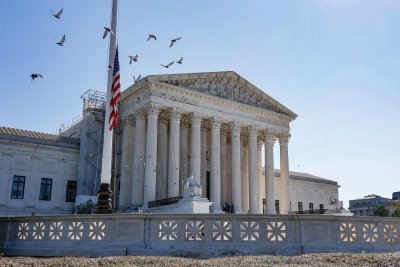
April 30 (UPI) — The Supreme Court is being asked to decide if a Catholic school in Oklahoma can be the first to be funded by taxpayers.
Oral arguments will be heard Wednesday if the school can become the first religious charter school in the United States, or if the First Amendment, which separates church and state, means only nonsectarian schools can qualify as charter schools that are publicly funded.
St. Isidore of Seville Catholic Virtual School, created by the Archdiocese of Oklahoma City and the Diocese of Tulsa in 2023, said state funding for charter schools is generally made available to qualified organizations and that the state cannot discriminate based on religion.
The Supreme Court has previously ruled that taxpayer-funded public benefit programs, such as school vouchers and state-run scholarships, are equally available, even if a person or organization has a religious affiliation.
“Oklahoma may exclude religious charter schools because six features, ‘free, open to all, funded by the State, subject to state control, nondiscriminatory, and nonsectarian’ purportedly establish charter schools as ‘public schools’ and thus governmental actors for federal constitutional purposes,” Oklahoma Attorney General Gentner Drummond argued.
The state’s highest court ruled last year that taxpayer-funded religious schools violate both the state and U.S. constitutions, and warned that should St. Isidore become the first public religious school in the nation, it would have “sweeping consequences.”
“A ruling that Oklahoma’s charter-school law unconstitutionally discriminates against religion would upend the federal [Charter Schools Program] and charter-school laws nationwide, sowing chaos and confusion for millions of charter-school students,” the state Supreme Court said.
The federal government currently defines charter schools as “public schools of choice that are created in accordance with state laws and are publicly funded and tuition-free.”
A decision in the case is expected by June.
Columbia University pro-Palestinian activist Mahdawi released | Israel-Palestine conflict
“President Trump… I am not afraid of you.” Columbia University student activist Mohsen Mahdawi was freed on bail Wednesday from custody in Vermont. Mahdawi was arrested in April by US immigration officials over his role in pro-Palestinian protests on campus.
Published On 30 Apr 2025
Yellowstone finally confirms update on Beth and Rip's return – and it's sooner than you think
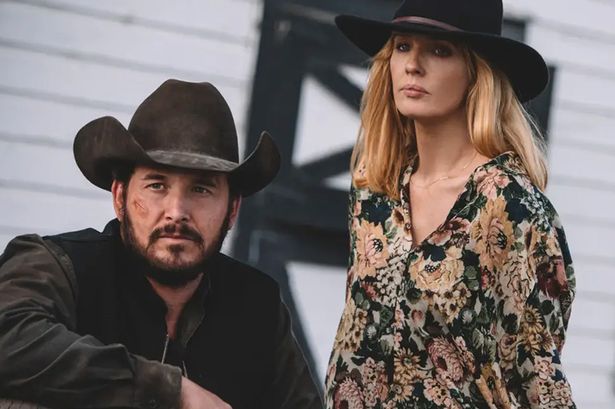
Yellowstone fans have been eagerly awaiting the return of Beth Dutton and Rip Wheeler after the Duttons’ story seemingly concluded in the series finale last December
Source link
Trump blames predecessor as US economy hit by tariff policies | Donald Trump News
President asks for ‘patience’ as businesses react negatively to Trump’s aggressive efforts to upend global trade.
United States President Donald Trump blames former president Joe Biden for the decline of key economic indicators during his first months as president, amid widespread disruptions caused by Trump’s tariff policies.
The US economy contracted by 0.3 percent during the first quarter of the year, the first such drop in three years. During the last three months of 2024, the economy grew by 2.4 percent.
“This is Biden’s Stock Market, not Trump’s,” Trump said in a post on his website Truth Social. “Tariffs will soon start kicking in, and companies are starting to move into the USA in record numbers. Our Country will boom, but we have to get rid of the Biden ‘Overhang.’ This will take a while, has NOTHING TO DO WITH TARIFFS, only that he left us with bad numbers, but when the boom begins, it will be like no other. BE PATIENT!!!”
Since taking office, Trump’s efforts to upend the global trade system through a series of aggressive import duties have caused turmoil in financial markets amid fears of an escalating trade war and uncertainty surrounding the tariff policies.
The first quarter saw an uptick in imports, as US businesses seek to get out ahead of higher costs that could accompany future tariffs. Inflation, however, continues to ease. In March, consumer prices were 2.3 percent higher than they were a year earlier, compared with 2.5 percent in February.
In a press release from the White House, press secretary Karoline Leavitt mirrored Trump’s claims that Biden was to blame for any turbulence while also stating that the Wednesday economic report showed “strong economic momentum”.
“It’s no surprise the leftovers of Biden’s economic disaster have been a drag on economic growth, but the underlying numbers tell the real story of the strong momentum President Trump is delivering,” Leavitt said.
Many economic analysts blame Trump’s chaotic approach to tariffs for the US’s flagging indicators. Since taking office, the S&P 500 has shrunk by about 7.3 percent.
“If the blowout on trade was the result of firms pre-buying imported inputs to beat the tariffs, the decay in the trade balance will reverse in second quarter,” Carl Weinberg, chief economist at High Frequency Economics, told the news agency Reuters. “That will generate some GDP growth. However, corrosive uncertainty and higher taxes, tariffs are a tax on imports, will drag GDP growth back into the red by the end of this year.”
In recent weeks, the White House has suggested that it could draw down tariffs with key US trading partners such as China, with Treasury Secretary Scott Bessent stating last week that current rates were not “sustainable”.
Holidaymakers warned of 10 food items you can no longer bring back from France
France is a favourite holiday hotspot for UK holidaymakers particularly if you have a motorhome but you need to be aware of a new government ban on food exports
It’s that time of year when we are getting ready for our summer hols. There’s always a lot of planning and organisation involved but this year there is a new ban holidaymakers must be aware of when they are packing.
As of April 25 2025, the UK government has placed a temporary ban on Brits bringing back certain EU products to try to prevent the spread of foot and mouth disease.
And travellers to France will need to know what they can and can’t bring back into the UK from their time holidaying across the Channel – so they can declare the products accurately.
The border forces will be able to seize and destroy the products accordingly. However if holidaymakers don’t declare the banned products on their return, they risk being prosecuted.
The Mirror looks at what travellers can and can’t bring back to the UK and what you can plan to bring into the EU, according to Ripe Motorhouse Insurance who has collated a handy guide.
READ MORE: ‘I was urged to avoid a holiday to this popular Italian city – but I went anyway’
What can you bring back from the EU into the UK?
Some types of poultry, specifically goose, duck chicken or any products containing these meats.
Products from these animals – such as eggs.
What can’t you bring to the UK?
Since April 12th 2025, Brits have not been allowed to bring back the following EU products:
Beef, Pork, Goat, Lamb, Mutton, Venison and any product containing these meats.
Pet food or food not for consumption that contains any of these meats.
Dairy products – such as cheese, yoghurt and butter.
What food can I take to France in my motorhome?
You can bring any fruit and vegetables into France that are grown originally within the EU, provided they are free from disease or any pest.
You can also bring in chocolates or other confectionery and processed foods,, but they must not have any dairy or meat ingredients.
Fruit and vegetables. However if they were grown in the UK or outside the EU you must be able to show a relevant plant health certificate. Exceptions include coconuts, dates, bananas, and pineapples.
Fish and seafood such as lobsters, prawns, mussels, and snails. Please note that the mussels and snails must be dead.
“Our handy guide for holiday goers on what to not bring back from France will save unnecessary delays in returning home in your motorhome,” says Alan Thomas, CEO of Ripe Motorhome Insurance. “As the bans are only temporary, travellers should check before setting off what they can bring back to ensure the UK isn’t currently affected by foot and mouth disease in the EU.”
Cancer is daunting and frightening, says King Charles as he opens up on health battle and quotes Dame Debs
KING Charles says cancer diagnosis is “daunting and at times frightening” but the “darkest moments of illness can be illuminated by the greatest compassion” as he hails health heroes.
Charles, who has been treated for cancer every week for more than a year, penned an optimistic message saying “cancer diagnosis need never mean facing the future without hope and support”.
He described how he and Queen Camilla had both seen “first hand” work of health care professionals and those behind cancer research breakthroughs saying they “have my whole family’s deepest admiration and gratitude”.
And hailed Sun columnist Dame Deborah James, who died of bowel cancer in 2022, as “an inspiration to us all, in sickness and in health”.
Tonight he is hosting a reception at Buckingham Palace to “celebrate and above all thank” health heroes who “selflessly give care, comfort and reassurance” to the 1,000 people every day diagnosed with cancer.
In a written message for the event, he added: “But as one among those statistics myself, I can vouch for the fact that it can also be an experience that brings into sharp focus the very best of humanity.”
Among the guests at the palace today include Alistair and Heather James, parents of Bowelbabe Dame Deborah.
In his message he celebrated Dame Debs, who died in June 2022 aged just 40-years-old, and echoed her words of support for “those who may be receiving such upsetting news today, tomorrow or at any point in the future.”
Quoting Debs, he said: “‘Find a life worth enjoying; take risks; love deeply; have no regrets; and always, always have rebellious hope.”
Charles, 76, is having weekly cancer treatment fourteen months after his diagnosis.
The Princess of Wales, 43, who is in remission, has also been on a long cancer struggle.
The King is joined by Camilla and The Duchess of Gloucester at the Community Based Cancer Support Reception at Buckingham Palace which kicks off at 6.15pm.
Writing in the event’s programme the King says: “My wife and I are delighted to host you here this evening to celebrate and above all thank those who so selflessly give care, comfort and reassurance to the 390,000 people who, sadly, receive a new cancer diagnosis across the U.K. each year. That is over 1,000 new cases every single day.
“Each diagnosis, each new case, will be a daunting and at times frightening experience for those individuals and their loved ones. But as one among those statistics myself, I can vouch for the fact that it can also be an experience that brings into sharp focus the very best of humanity.
“It has certainly given me an even deeper appreciation of the extraordinary work undertaken by the remarkable organisations and individuals gathered here this evening, many of whom I have known, visited and supported over the years.
“And it has reinforced what I have long observed during these visits – that the darkest moments of illness can be illuminated by the greatest compassion.
“As patrons of many such organisations, The Queen and I have seen at first-hand how you not only fund vital research and deliver exceptional healthcare but also create spaces where patients and their families find sanctuary, understanding and practical assistance when they need it most.
“What strikes us repeatedly is the profound impact of human connection – whether in the careful explanation from a specialist nurse, the hand held by a hospice volunteer, or the shared experience in a support group.
“These moments of kinship create what I might call a “community of care”, one that sustains patients through the most difficult of times.
“So to all the researchers pursuing pioneering breakthroughs; to the healthcare professionals providing specialist treatment; to the volunteers offering comfort, or campaigning to raise awareness; and to the fundraisers enabling all this vital work – you have my whole family’s deepest admiration and gratitude.
“Your commitment to early diagnosis, evermore successful therapies and truly holistic care represents the very best our country can offer.
“This collective endeavour reminds us of what we can achieve when we are united with common purpose and uncommon determination. While every patient’s journey may be different, together you are ensuring that a cancer diagnosis need never mean facing the future without hope and support.
“And to those who may be receiving such upsetting news today, tomorrow or at any point in the future, I can only echo the departing words of the late Dame Deborah James, whose parents I am delighted to have with us here this evening, and whose example stands as an inspiration to us all, in sickness and in health: ‘Find a life worth enjoying; take risks; love deeply; have no regrets; and always, always have rebellious hope.’ I am so very grateful for all that you do. Charles R.”
Charles was taken to hospital last night after side effects from his cancer treatment and forced to cancel a string of engagements.
But he was able to carry out a State Visit to Italy although unable to see his wayward son Harry when he jetted in 24 hours before the trip as he was having his weekly cancer treatment.
Other guests at the Community Based Cancer Support Reception includes heroes of cancer charities and people living with cancer including Adele Roberts, Ashley Cain, Richard E Grant.
Charity heroes thanked at the palace included those from The King and Queen’s patronages, including Macmillan Cancer Support, Breast Cancer Now, Maggie’s and Children’s Hospice South West.
The King and Queen are also to watch a short performance by the ITV Change + Check Choir which is made up of 26 women who all spotted their breast cancer symptoms after seeing the awareness campaign on Lorraine Kelly’s ITV1 programme Lorraine.
Trump dismisses Biden nominees to U.S. Holocaust Memorial Council, including Doug Emhoff
WASHINGTON — President Trump has dismissed many of former President Biden’s nominees to the United States Holocaust Memorial Council, including Doug Emhoff, the husband of former Vice President Kamala Harris.
Emhoff, who is Jewish and who led the Biden administration’s efforts to combat antisemitism, criticized Trump’s action, saying, “Let me be clear: Holocaust remembrance and education should never be politicized.”
He added, “To turn one of the worst atrocities in history into a wedge issue is dangerous — and it dishonors the memory of 6 million Jews murdered by Nazis that this museum was created to preserve.”
Others dismissed alongside Emhoff include former Biden chief of staff Ron Klain and former domestic policy adviser Susan Rice, who was the principal author of and the impetus behind the first-ever comprehensive National Strategy to Combat Antisemitism in 2023.
Anthony Bernal, a senior advisor to former First Lady Jill Biden, confirmed he was also dismissed.
The White House did not immediately respond to a request for comment.
Since taking office in January, Trump has moved to fire many Biden appointees across government — including ostensibly apolitical roles. Biden, too, dismissed some Trump carryover appointees after he entered the White House in 2021, most notably 18 appointees named to U.S. military academy boards, but at a far smaller scale.
Miller and Superville write for the Associated Press.
Alijah Arenas released from hospital, expected to fully recover
Top USC basketball recruit Alijah Arenas has been released from the hospital and is resting comfortably, his family announced in a statement Wednesday.
Arenas lost control of his Tesla Cybertruck just before 5 a.m. PDT Thursday as he was returning from the gym, according to Josiah Johnson, who co-hosts the “Gil’s Arena” podcast with Alijah Arenas’ father, former NBA player Gilbert Arenas. The car struck a fire hydrant and a tree on Corbin Avenue in Reseda and caught fire with Arenas inside. The player’s family said in a statement released Friday that “brave individuals” helped rescue Arenas from the burning vehicle. One told the family that they heard “banging on the car window, but I couldn’t see anything because the smoke was so thick.” But onlookers were able to pull him out of the car.
A crumbled Telsa Cybertruck rests adjacent to a tree following a crash involving top USC basketball recruit Alijah Arenas.
(Handout)
Arenas was joined at the hospital by his father; mother, Laura Govan; siblings; and extended family.
“While his journey to full recovery is just beginning, his spirit remains strong, and he is surrounded by love and support,” the family’s statement released Wednesday read. “The Govan and Arenas family are preparing for the road ahead with faith and determination, committed to nurturing Alijah back to 100%. He remains blessed, resilient and in high spirits. The family continues to ask for privacy during this time as they focus fully on Alijah’s healing and well-being. We thank everyone for the continued prayers, encouragement, and outpouring support.”
Arenas was deemed “stable” at the scene, according to LAPD officer Rosario Cervantes. Drugs and alcohol were not suspected to be a factor in the crash, a source with knowledge of the investigation not authorized to discuss it publicly told The Times.
At the hospital, Arenas was placed in an induced coma “as a result of smoke inhalation,” according to Johnson, the “Gil’s Arena” podcast” co-host. Johnson said Arenas sustained no major injuries in the single-car accident.
Arenas, a top-10 prospect nationally and a key member of USC’s 2025 recruiting class, led Chatsworth to the CIF state championship game last month. He leaves the school as the City Section’s all-time leading scorer, with more than 3,000 points. Arenas was expected to play a significant role for the Trojans next season as a freshman.
Staff writer Richard Winton contributed to this report.
Pro-Palestinian students confront University of Manchester leadership | Israel-Palestine conflict
Video from the Youth Front for Palestine shows student activists interrupting a meeting of University of Manchester leaders to demand the school sever ties with Israel’s Tel Aviv University. The school’s leadership defended its decision to maintain ties, saying that doing so is not in support of genocide or Israel.
Published On 30 Apr 2025
Gerry Adams tells court BBC report was attempted hatchet job on him
BBC News NI
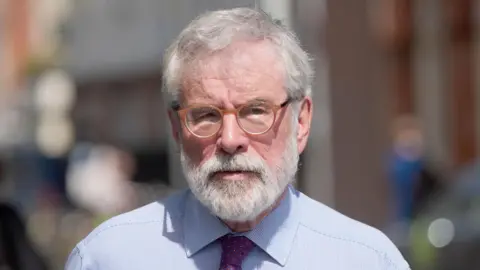 PA Media
PA MediaGerry Adams has described a BBC TV programme on the murder of an informer as an “attempted hatchet job” on him.
The former Sinn Féin president was giving evidence in his libel case against the BBC at the High Court in Dublin.
He claims the programme, and an accompanying online story, defamed him by alleging he sanctioned the killing of the former Sinn Féin official Denis Donaldson.
Mr Donaldson, who had worked for Sinn Féin, was shot dead in Donegal in 2006, months after admitting his role as a police and MI5 agent for 20 years.
Mr Adams denies any involvement.
In 2009, the Real IRA admitted killing Mr Donaldson.
The case is being heard by a jury at the High Court in Dublin and could last four weeks.
On Wednesday, the hour-long BBC NI Spotlight TV documentary was shown to the jury.
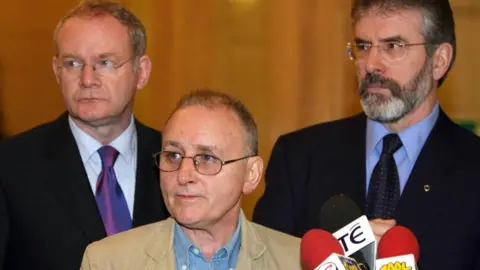 PA Media
PA Media‘Poor journalism’
Under questioning by his own barrister, Mr Adams said he watched the programme at the time it was first broadcast in 2016, and recalled being “astonished” by its “poor journalism”.
He said to suggest the Provisional IRA was involved in the murder of Mr Donaldson was “wholly contrary” to the instructions the paramilitary organisation had publicly given its members in 2005 to stand down because there was “a peaceful alternative to armed struggle”.
Mr Adams also alleges he was defamed in a BBC online article based on the broadcast, which contained claims made by an anonymous source.
He held up a printed copy of the online article and said there “there was an arrogance involved” in the BBC’s response to requests from his legal representatives for it to be taken off the website.
He said the BBC had “given no reason” why the article was still available online nine years later.
During pre-trial hearings, the BBC argued the broadcast and publication were put out in good faith and concerned a matter of public interest.
It stated the reports constituted responsible journalism as a result of careful investigation.
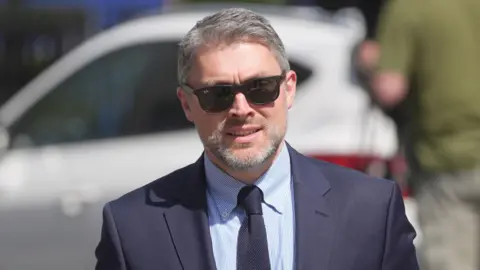 PA Media
PA MediaEarlier on Wednesday, Mr Adams told the libel jury he was “shocked” when told Mr Donaldson had been shot dead at a remote cottage in Donegal.
He said he learned of the killing in a phone call from the then Northern Ireland Secretary Peter Hain.
“The Sunday World carried the story a few weeks before and there was a photograph outside cottage,” Mr Adams said.
“I presumed he had moved and hadn’t left himself vulnerable, but unfortunately he didn’t.
“I think Denis Donaldson was a victim of the conflict.
“The fact his family is still struggling to get the truth, even an inquest, is deeply troubling.”
‘Alternative’ to IRA needed
Mr Adams also spoke about the outset of the Northern Ireland Troubles, when “the entire situation moved from a civil rights struggle to a conflict situation”.
He spoke about his internment without trial in the 1970s and the 1981 Republican hunger strikes, by which time he was Sinn Féin vice-president.
One of those who died on hunger strike was Bobby Sands, who was elected an MP months earlier.
“A number of us were trying to revamp Sinn Féin,” Mr Adams said.
“What Bobby’s [Sands] election did was accelerated that process.
“That was the commencement of the Sinn Féin electoral strategy, but also the notion you could go forward peacefully.”
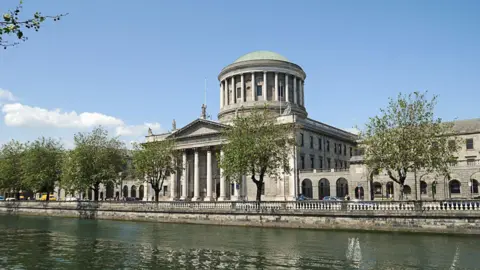 Getty Images
Getty ImagesMr Adams then talked about the development of the peace process.
“The IRA was legitimate response to [British] occupation. That’s not to say everything they did was legitimate, it wasn’t.”
He said he told a priest, Fr Alec Reid: “If we want the IRA to stop, we have to produce an alternative.
“That became my mantra.”
Mr Adams said he was “shocked” at how long things took.
“It was too long and all the time there were people being killed – there were atrocities, including on the republican side,” he said.
Mr Adams is due to continue giving evidence when proceedings resume on Thursday morning.
The case continues.
Who is Gerry Adams?
Mr Adams was the president of republican party Sinn Féin from 1983 until 2018.
He served as MP for Belfast West from 1983 to 1992 and again from 1997 until 2011 before sitting as a TD (Teachta Dála) in the Dáil (lower house of Irish parliament) between 2011 and 2020.
Mr Adams led the Sinn Féin delegation during peace talks that eventually brought an end to the worst violence of the Troubles with the signing of the Good Friday Agreement in 1998.
He was detained in the early 1970s when the government in Northern Ireland introduced internment without trial for those suspected of paramilitary involvement.
Mr Adams has consistently denied being a member of the IRA.
Who was Denis Donaldson?
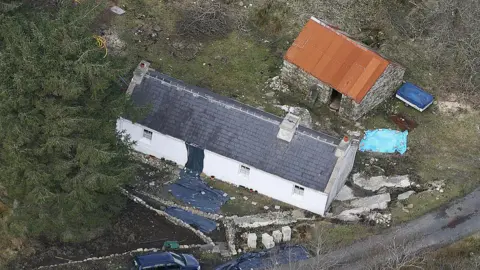 Getty Images
Getty ImagesMr Donaldson was once a key figure in Sinn Féin’s rise as a political force in Northern Ireland but he was found murdered in 2006 after it emerged he had been an informer.
He was interned without trial for periods in the 1970s.
After the signing of the Good Friday Agreement, Sinn Féin appointed Mr Donaldson as its key administrator in the party’s Stormont offices.
In 2005 he confessed that he was a spy for British intelligence for two decades, before disappearing from Belfast.
Mysterious ‘alien’ shark only seen in ocean depths found prowling off coast of hols hotspot Gran Canaria by fishermen
A MYSTERIOUS alien shark only ever seen in the depths of the ocean has been spotted prowling off the coast of Gran Canaria.
The horror sighting left local fishermen stunned as the giant goblin shark flashed his razor sharp teeth.
Shocking footage showed the shark lurking in the water before it flashed its teeth.
The creature was spotted by local fishermen Marcos Hernández and Ramón Santana.
The pair were hunting for hake and deep water perch at a depth of around 900 metres when they spotted the shark.
Marcos said that neither he nor Ramón had any idea what it was when they first spotted the goblin shark.
Marcos said: “When it came up, we had no idea what it was.
“At first, we thought it was a swordfish because of the snout but then we realised it wasn’t.
“It had leathery skin and after looking online, we understood what it really was.”
The fishermen captured the goblin shark to take a closer look before releasing it back into the ocean.
The terrifying creature was spotted off the coast of San Cristóbal in Gran Canaria, Spain.
According to local press, this is the first confirmed sighting of this species in these particular waters.
Goblin sharks are also known as Mitsukurina owstonis.
The beast is often referred to as a “living fossil” – best known for its protrusible jaw and elongated beak.
This comes as a 40-year-old man was torn apart by sharks near Hadera in Israel in April.
The beach famously attracts sharks, and people often play with the animals – even pulling their tails and hand-feeding them fish.
Footage from the beach shows parents allowing their kids to paddle amongst the creatures moments before the fatal frenzy.
Beach-goers could do nothing but watch as the swimmer was ripped apart in the waves – with harrowing footage capturing the moment the water around him foams red with blood.
Experts have urged holidaymakers visiting these spots to be vigilant, and outlined how to stay safe in the water.
Kashmir attack: How India might strike Pakistan – what history tells us | Border Disputes News
Pakistan said on Wednesday that it had “credible intelligence” that India might launch a military strike against it within the next few days.
Meanwhile, Indian Prime Minister Narendra Modi led a series of security meetings on Tuesday and Wednesday, adding to speculation of an impending Indian military operation against its archrival, after the April 22 attack on tourists in Pahalgam in Indian-administered Kashmir in which 26 people were killed.
Since the attack, barely existent relations between the nuclear-armed South Asian neighbours have nosedived further, with the countries scaling back diplomatic engagement, suspending their participation in bilateral treaties and effectively expelling each other’s citizens.
The subcontinent is on edge. But how imminent is an Indian military response to the Pahalgam killings, and what might it look like? Here’s what history tells us:
What happened?
Pakistan’s Information Minister Attaullah Tarar said in a televised statement early on Wednesday that Islamabad had “credible intelligence” that India was planning to take military action against Pakistan in the “next 24 to 36 hours”.
Tarar added that this action would be India’s response on the “pretext of baseless and concocted allegations of involvement” in Pahalgam. While India has alleged Pakistan’s involvement in the Pahalgam attack, Islamabad has denied this claim.
India and Pakistan each administer parts of Kashmir, but both countries claim the territory in full.
Tarar’s statement came a day after Modi gave the Indian military “complete operational freedom” to respond to the Pahalgam attack in a closed-door meeting with the country’s security leaders, multiple news agencies reported, citing anonymous senior government sources.
On Wednesday, Modi chaired a Cabinet Committee on Security meeting, the second such meeting since the Pahalgam attack, state-run Doordarshan television reported.
Meanwhile, as the neighbours continued to exchange gunfire along the Line of Control (LoC) dividing Indian and Pakistan-administered Kashmir, other world leaders stepped up diplomacy to calm tensions.
“We are reaching out to both parties, and telling … them to not escalate the situation,” a United States state department spokesperson told reporters on Tuesday, quoting US Secretary of State Marco Rubio, who is expected to speak to the foreign ministers of India and Pakistan.
Also on Tuesday, the spokesperson for United Nations Secretary-General Antonio Guterres said that he had spoken to Pakistan Prime Minister Shehbaz Sharif and Indian Foreign Minister Subrahmanyam Jaishankar, offering his help in “de-escalation”.
What military action could India take?
While it is unclear what course of action India could take, it has in the past used a range of military tactics. Here are some of them:
Covert military operations
By design, they aren’t announced – and aren’t confirmed. But over the decades, India and Pakistan have each launched multiple covert raids into territory controlled by the other, targeting military posts, killing soldiers – and on occasion beheading the enemy’s troops.
These strikes are often carried out as a retaliatory step by a military unit whose personnel were themselves previously attacked, as a form of retribution.
But such raids are never confirmed: The idea is to send the other country a message but not force it to respond, thereby containing the risk of escalation. Public announcements lead to domestic pressure on governments to hit back.
Publicised ‘surgical strikes’
Sometimes, though, the idea is not to send subtle messages – but to embarrass the other country by making an attack public. It also doesn’t hurt politically.
India has in the past carried out so-called surgical strikes against specific, chosen targets across the LoC – most recently in 2016.
Then, after armed fighters killed 17 Indian soldiers in Uri, Indian-administered Kashmir, special forces of the Indian Army crossed the de facto border to attack “launch pads” from where, New Delhi alleged, “terrorists” were planning to strike India again. “The operations were basically focused to ensure that these terrorists do not succeed in their design of infiltration and carrying out destruction and endangering the lives of citizens of our country,” Lieutenant General Ranbir Singh, then the director-general of military operations for the Indian Army, said in a public statement, revealing the raid.
India claimed that the surgical strike had killed dozens of fighters, though independent analysts believe the toll was likely much lower.
Aerial strikes
In February 2019, a suicide bomber killed 40 Indian paramilitary soldiers in Pulwama in Indian-administered Kashmir, weeks before national elections in the country. This attack was claimed by the Jaish-e-Muhammad, an armed group based in Pakistan.
Amid an outpouring of rage, the Indian Air Force launched an aerial raid into Pakistan-administered Kashmir. India claimed it had struck hideouts of “terrorists” and killed several dozen fighters.
Pakistan insisted that Indian jets only hit a forested region, and did not kill any fighters. Islamabad claimed it scrambled jets that chased Indian planes back across the LoC.
But a day later, Indian and Pakistani fighter jets again engaged in a dogfight – this one ending with Pakistan downing an Indian plane inside territory it controls. An Indian fighter pilot was captured, and returned a few days later.
Attempts at taking over Pakistan-controlled land
Over the past few years, there have been growing calls in India that New Delhi should take back Pakistan-administered Kashmir. That chorus has only sharpened in recent days after the Pahalgam attack, with even leaders of the opposition Congress Party goading the Modi government to take back that territory.
While retaking Pakistan-administered Kashmir remains a policy objective of every Indian government, the closely matched military capabilities of both sides make such an endeavour unlikely.
Still, India has a track record of successfully taking disputed territory from Pakistan.
In 1984, the Indian Army and Indian Air Force launched Operation Meghdoot, in which they rapidly captured the Siachen glacier in the Himalayas, blocking the Pakistan Army from accessing key passes. One of the world’s largest non-polar glaciers, Siachin has since been the planet’s highest battleground, with Indian and Pakistani military outposts positioned against each other.
Naval missions
In the aftermath of the Pahalgam attack, the Indian Navy announced that it had carried out test missile strikes.
“Indian Navy ships undertook successful multiple anti-ship firings to revalidate and demonstrate readiness of platforms, systems and crew for long range precision offensive strike,” the navy said in a statement on April 27.
“Indian Navy stands combat ready, credible and future ready in safeguarding the nation’s maritime interests anytime, anywhere, anyhow.”
Many analysts have suggested that the trials were a show of strength, pointing to the Indian Navy’s ability to strike Pakistani territory if ordered to do so.
A full-blown military conflict
India and Pakistan have gone to war four times in the 78 years of their independent existence. Three of these armed conflicts have been over Kashmir.
Two months after the British colonial government left the subcontinent in August 1947 after carving it up into India and Pakistan, the neighbours fought their first war over Kashmir, then ruled by a king.
Pakistani militias invaded Kashmir to try and take control. The king, Hari Singh, pleaded with India for help. New Delhi agreed, and joined the war against Pakistan, but on the condition that Singh sign an instrument of accession, merging Kashmir with India. The king agreed.
The war finally ended on January 1, 1949, with a ceasefire agreement. India and Pakistan have both held parts of Kashmir since then.
In 1965, a clash between their border forces escalated into a full-blown war. Pakistani forces crossed the ceasefire line into Indian-administered Kashmir, while Indian forces crossed the international border into Pakistan’s Lahore and launched attacks. After thousands of casualties on both sides, a United Nations Security Council resolution helped the neighbours end the war.
In 1971, Pakistan and India were embroiled in an armed conflict over East Pakistan, where Indian forces helped liberate the territory, leading to the establishment of Bangladesh. In 1972, the two countries signed the Simla Agreement, which established the LoC.
In 1999, the Pakistani military crossed the LoC, sparking the Kargil War. Indian troops pushed the Pakistani soldiers back after bloody battles in the snowy heights of the Ladakh region.
